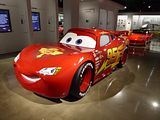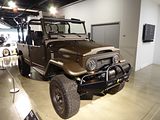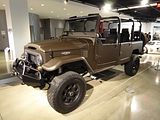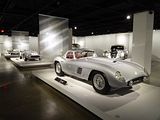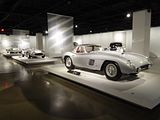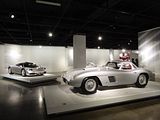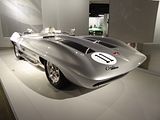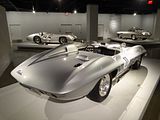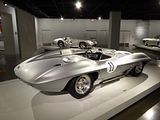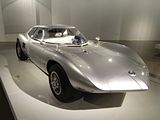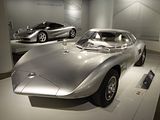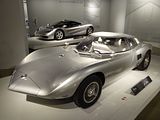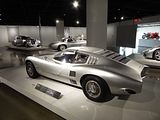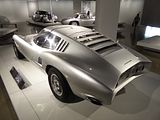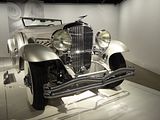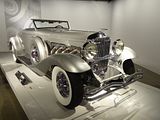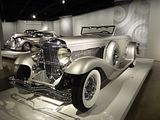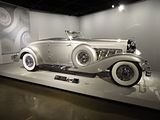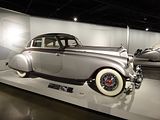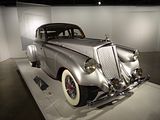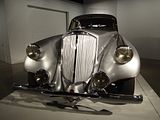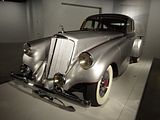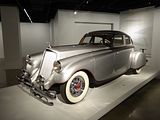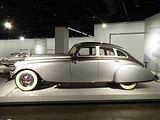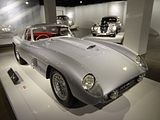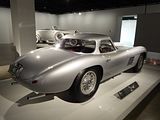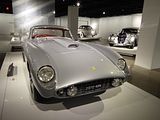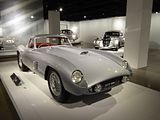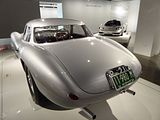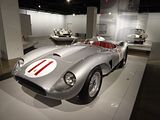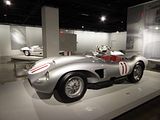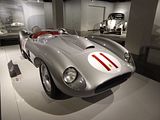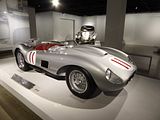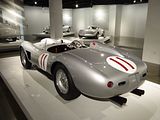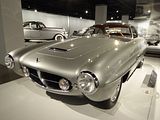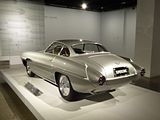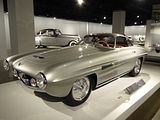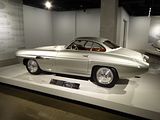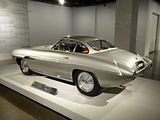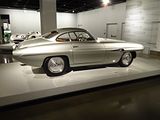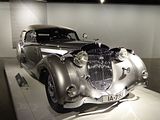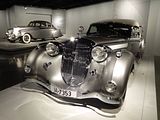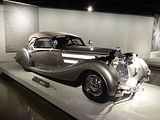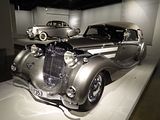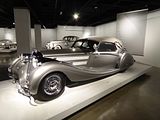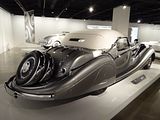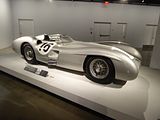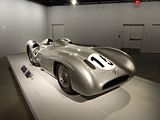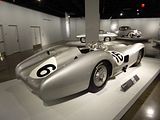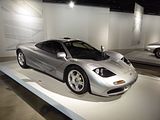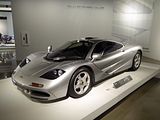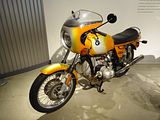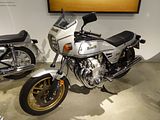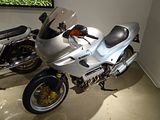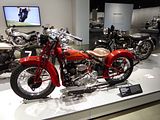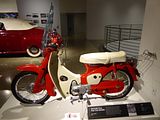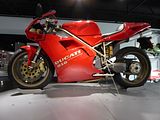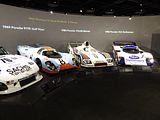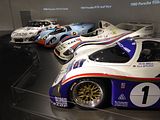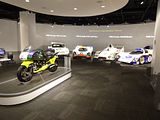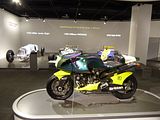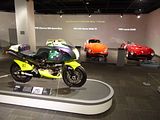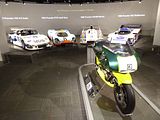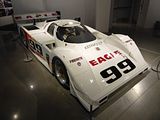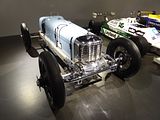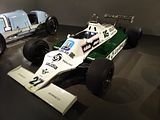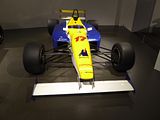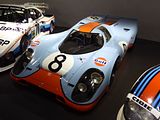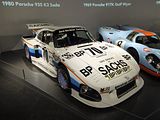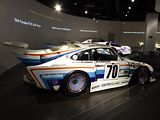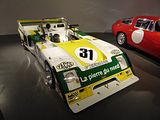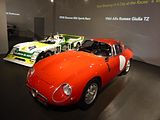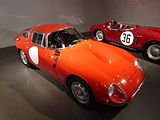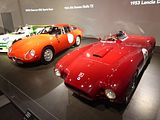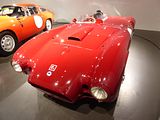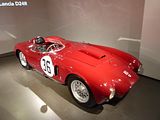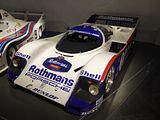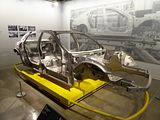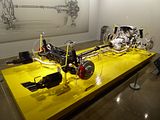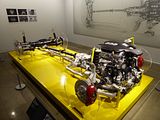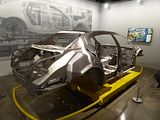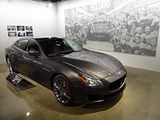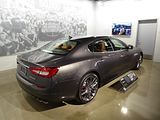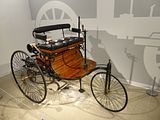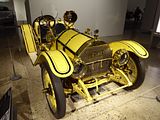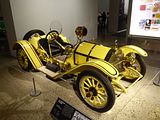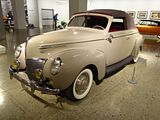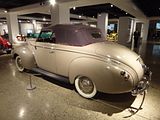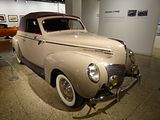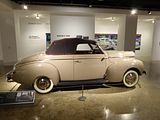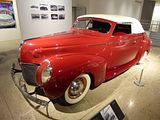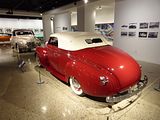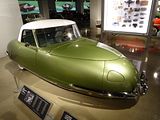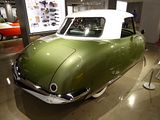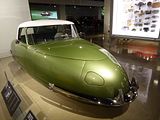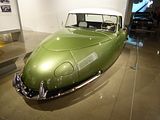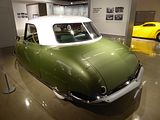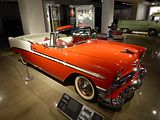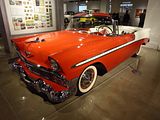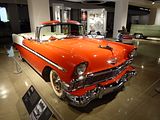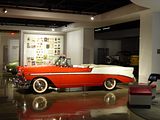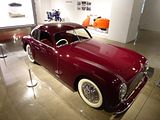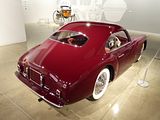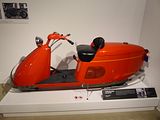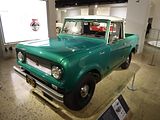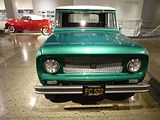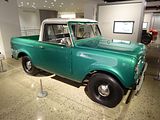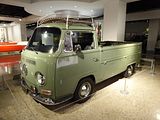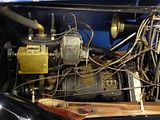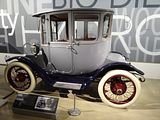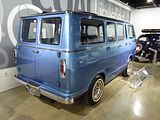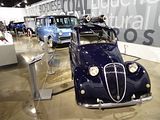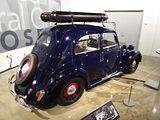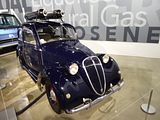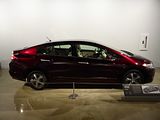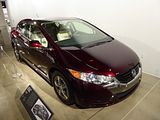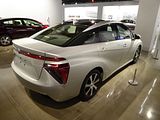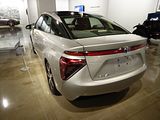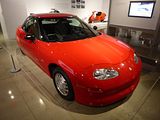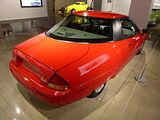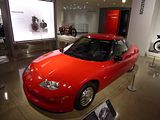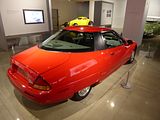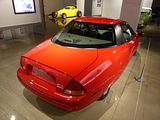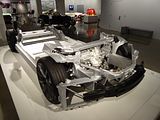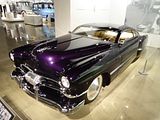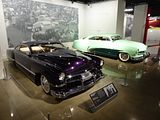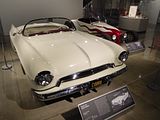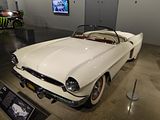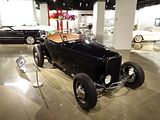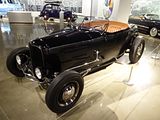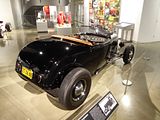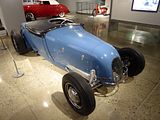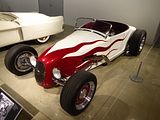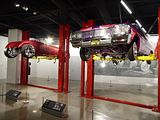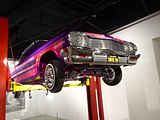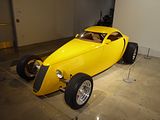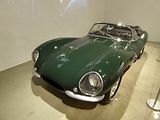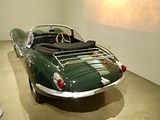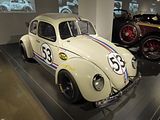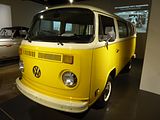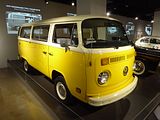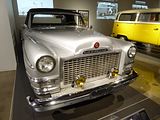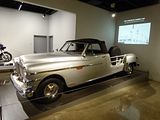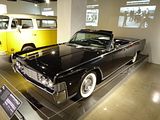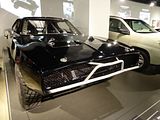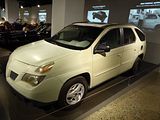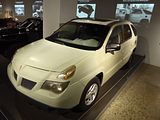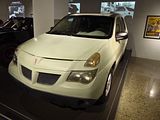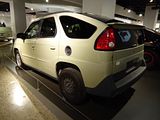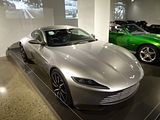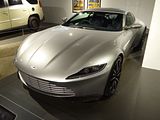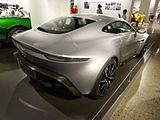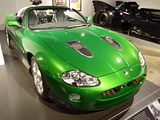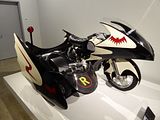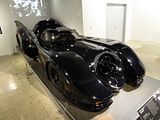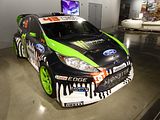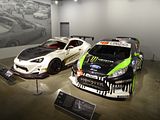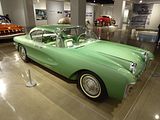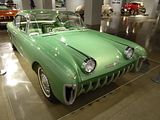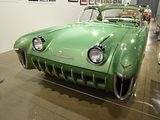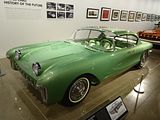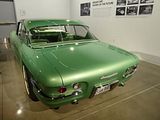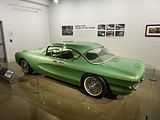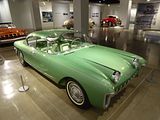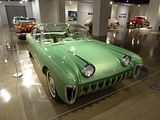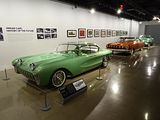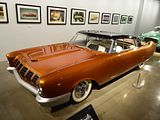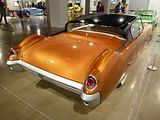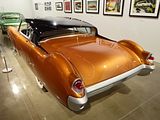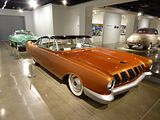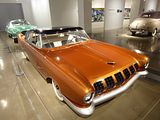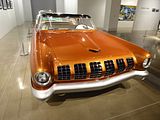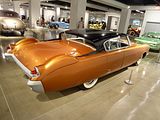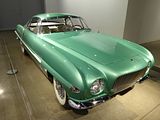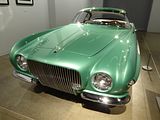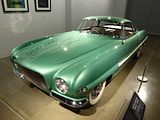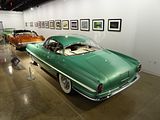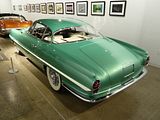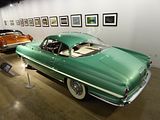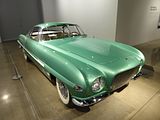Americans have been in love with the automobile ever since the early days of the twentieth century when their fellow countryman Henry Ford enabled so many of them to get behind the wheel of the car, and nowhere is this more true than in Los Angeles, so it is perhaps no surprise to discover that one of the best automotive museums in the US, if not the world is to be found in that city. Called the Petersen, after its founder, it is located in what is known as Museum Mile, on the Wilshire Boulevard, in that area of the metropolis that is between Beverley Hills and Santa Monica. The museum was founded on June 11, 1994 by magazine publisher Robert E. Petersen and his wife Margie. Initially it was located within the Natural History Museum of Los Angeles County, and later moved to a historic department store designed by Welton Becket. Opened in 1962, the building first served as a short-lived U.S. branch of Seibu Department Stores, before operating as an Ohrbach’s department store from 1965 to 1986. Six years after Ohrbach’s closed, Robert Petersen selected the largely windowless site as an ideal space for a museum—allowing artifacts to be displayed without harmful exposure to direct sunlight. Petersen died in 2007 but before this he and his wife had created the Petersen Foundation, which has given the collection and the museum a sound future.
Like many large collections, there is never space for everything to be shown at once, even before taking into account the loan of display-worthy vehicles from other sources, so it pays to make regular repeat visits. Although I do go to Los Angeles two or three times a year, I never seem to find the time to stop by, so it is several years since my last visit, but I was particularly keen to fix that as for several months in 2015, the museum was closed for an extensive $90m make-over not just of the interior, but also the outside. The old building was hardly what you would call memorable, but that has been addressed with a very bold new look. 100 tons of 14-gauge type 304 steel in 308 sections, 25 supports and 140,000 custom stainless-steel screws were used to produce something very distinctive which is designed to allude to the sort of flame decals you would see on a hot-rod. The new look has drawn praise and criticism in equal measure, as it is quite unlike anything else in the area. You certainly won’t miss the building as you drive by!
Attracted by what the museum calls a “Cruise In”, which amounted to a “Cars and Coffee” style meet, which typically happen once a month, taking place on the upper outdoor deck of the parking structure next to the museum, I decided to stay on after the majority of the show cars had gone to investigate the revamped museum from the inside, so presented here is what was on display at the time of this visit in March 2016.
At any one time there are around 100 vehicles on display in 25 separate galleries. The remainder of the collection is kept in a vault, located on the basement level of the building, which is now also available for public viewing, though there are age restrictions for this and there is an admission premium in effect. The ground floor of the main museum focuses on automotive artistry, showcasing an array of extravagant automobiles. The second floor is principally concerned with industrial engineering—including design, performance, and a collection of interactive teaching exhibits. Special displays on the industry floor cover racing, motorcycles, hot rods and customs. The third floor chronicles the history of the automobile with an emphasis on the car culture of Southern California. It took me several hours to wander, in a logical way though all 25 of the display halls.
First car that I came across as I entered the museum was this 2015 McLaren P1.
Next up was this spectacular Rolls Royce Phantom 1 with unique Jonckheere body, often referred to as the “round door” Rolls Royce. For over 15 years, the ’40/50′ Silver Ghost was the only model on offer, at a time where many of the competitors offered multiple of models and types. In 1922 it was joined by the Twenty, which was aimed at a slightly wider market. From 1921 onwards, the North American customers were served more directly by a new factory in Springfield, Massachusetts. The ‘Springfield’ Silver Ghosts were intended to be identical to the British built cars, but after a few cars were built, changes were carried through to comply with the North America’s needs. Competition from rivals like Hispano Suiza and Isotta Fraschini had grown considerably. In 1922 work was started on a larger, more powerful model to replace the Silver Ghost, which had served the British company so well for nearly two decades. Delayed several years because of other pre-occupations, the new Rolls-Royce was introduced to the public in May of 1925. First known as the ’40/50 New Phantom’, this model is now commonly referred to as Phantom I. Much of the development concentrated on the new straight six. In many ways this was a larger version of the ‘Twenty’ six cylinder engine introduced in 1922. Cast into two banks of three cylinders, the new engine was only slightly larger than the Ghost’s but performance was considerably improved by adaption of overhead valves. The first Phantoms featured cast-iron heads, which were later replaced by twin-plug, aluminium examples to cure ‘pinging’ problems when run on poor quality fuel. In good Rolls-Royce tradition all that was said about the power was that it was ‘sufficient’ but it is believed the Phantom ‘six’ developed around 100 bhp. The new engine was mounted in what was effectively a Silver Ghost chassis of the latest specification. Since 1923, this included such luxuries as brakes on all four wheels. The Phantom was available in two wheelbases to accommodate the widest variety of coachwork. As with the Silver Ghost, the Phantom was produced on both sides of the Atlantic. The ‘Springfield Phantom’ not only had the steering wheel mounted on the other side but to accommodate this change, the intake and exhaust ports on the engine were also reversed. As was the norm with the luxury cars of the day, the ‘New Phantom’ was offered by Rolls-Royce as a rolling chassis for specialist companies to body. In England most customers opted for more formal coachwork but the more extravagant Americans had developed a taste for the lavish. The likes of Brewster offered their bodies with exotic names like ‘Huntingdon’, ‘Pall Mall’ and ‘Playboy’. At the British factory several more rakish experimental (EX) models were also built to explore the options of a higher performance version of the Phantom to take on Bentley. Although well received by media and customers alike, the Phantom I would serve Rolls-Royce for a relatively short time. In 1929 the Phantom II was announced, which was the company’s first all new car since the Silver Ghost. Production of the Springfield Phantom continued into 1931 when the American branch was shut down altogether. Effectively an interim model, the original Phantom has long been overlooked but in recent years the interest in and passion for the ‘New Phantom’ is steadily increasing. The story of the original car is fascinating. The 1924 Rolls Royce Phantom l with a convertible body by Hooper was commissioned by an American lady from Detroit. The car never got to the States however, and was subsequently purchased by the Raja of Nanpara, an Indian regional potentate under British rule. It’s at this point that the vehicle was sent to the Jonckheere brothers in Belgium for its new hand-crafted body. Some reports suggest it was intended as a present for Prince Edward, but all records from the factory were lost in the war and it is not even known who originally penned the fantastic Art Deco body shape. The car was fitted with a 6-cylinder, 7.66L OHV inline six engine and a 4-speed manual transmission. The body was completely hand fabricated to include round doors, split-opening half-moon windows, twin sunroofs, bespoke luggage and a stabilizing fin at the rear. All told, the luxurious automobile was quiet enough to hold a conversation at speed and would easily travel at 100 mph. The vehicle changed hands many times in the 40s and 50s until it ended up with American Max Opie, who restored it and painted it with six pounds of gold dust and lacquer. After life as a travelling sideshow, it disappeared until 1991 when it was purchased by a Japanese gentleman for US$1.5 million. In 2004 it was purchased by the Petersen Museum and restored to its first incarnation of black gloss exterior and red leather interior. The vehicle is a popular attraction at Palm Beach and other classic car concours events, but in a cruel twist is unfortunately not eligible for the top prizes at these gatherings as the original records are lost.
Alfa Romeo launched the first TZ in 1962 to replace the SZ. A new version of TZ was introduced at the Turin Auto Show in 1964 in the Zagato stand. In order to reinforce the structure and further reduce the car’s weight, Zagato replaced the light alloy body with an even more streamlined fibreglass body moulded tight to the chassis providing lower drag and reduced weight of 620 kg (1,370 lb). The new design was called the Alfa Romeo Giulia TZ2. The TZ2 was only built as racing version; it was equipped with an Autodelta-prepared twin plug, dry sump lubrication 1,570 cc DOHC straight-4 engine producing around 170 bhp at 7000 rpm. With this engine the car reached top speed of 245 km/h (152 mph). The rear window was also changed, now single unit rather than three part window in TZ. Development of TZ cars was stopped in the end of 1965, to make room for the new Alfa Romeo GTA racing program. The TZ2 took class win on 25 April 1965 in the 1000 km of Monza, with Bussinello-De Adamich finishing seventh overall and first in the GT 1600 category. Also in 1965 it took class victories thanks to Rolland-Consten in the 12 Hours of Sebring; Bianchi-Rolland in the Targa Florio; and Adamich-“Geki” in the 1000 km of Nürburgring, the 6 Hours of Melbourne, the Giro d’Italia and the Criterium des Cevennes. There were further class wins the following year: at Monza (De Adamich-Zeccoli), Sebring (Andrey-“Geki”), in the Targa Florio (Pinto-Todaro) and at the Nürburgring (Bianchi-Schultze). Only 12 TZ2s were built. The car won the prestigious Gran Turismo Trophy at the 2009 Pebble Beach Concours d’Elegance.
This is a 1953 Bosley GT Mark 1. Intended as a dual-purpose sports/racing car, the Bosley had a 55 gallon gas tank making it ideal for long distance races. Built at a cost of over $9,000 this prototype remained the only Bosley GT Mark I ever built.
The Toyota 2000 GT was a front-engine, rear-wheel drive, two-seat, hardtop coupé grand tourer designed by Toyota in collaboration with Yamaha, first displayed to the public at the Tokyo Motor Show in 1965. It was then manufactured under contract by Yamaha between 1967 and 1970. In Japan, it was exclusive to Toyota’s Japanese retail sales channel called Toyota Store. The 2000GT revolutionised the automotive world’s view of Japan, then viewed as a producer of imitative and stodgily practical vehicles. As sleek, high-performance fastback, it demonstrated its auto makers could produce a sports car to rival the better marques of Europe. Most of the 2000GT’s design was done by Yamaha, which also did much automobile work for other Japanese manufacturers, originally for Nissan rather than Toyota. Many credit the German-American designer Albrecht Goertz, a protégé of Raymond Loewy who had previously worked with Nissan to create the Silvia, as inspiration. He had gone to work for Yamaha in Japan in the early 1960s to modernise Nissan’s two-seater Fairlady sports car. A prototype 2000GT was built, but Nissan declined. Yamaha then proposed the design to Toyota, whom they also did contract work for, then perceived as the most conservative of the Japanese car manufacturers. Wishing to improve their image, Toyota accepted the proposal, but employed a design from their own designer Satoru Noza. The resulting car is widely considered a classic among 1960s gran turismos. Its smoothly flowing “coke bottle” bodywork was executed in aluminium and featured pop-up headlights above large plexiglass covered driving lamps flanking the grille similar to those on the Toyota Sports 800. Bumpers were minimal, and the car was extremely low, just 45.7 in to the highest point of the roof. In spite of a custom open-top version built for the James Bond film You Only Live Twice, a factory-produced convertible was never offered. The engine was a longitudinally mounted 2.0 litre straight-6, based on the engine in the top-of-the-line Toyota Crown sedan. It was transformed by Yamaha with a new double overhead camshaft head into a 150 hp sports car unit, with three carburettors. A five speed manual gearbox was part of the spec. Just 351 examples were made, and on the rare occasions that one comes up for sale, you could well be looking at figures of half a million to buy one.
There were a number of bikes and a Ford-based hot rod in this area, a portent of what was to come.
THE MULLIN GALLERY
The largest display area on the first floor was given over to a fabulous collection of some of the most elegant cars of the 1930s. These were all special coachbuilt models for which money was no object when they were first constructed, their initial owners in many cases being royalty, the aristocracy or the very wealthy such as movie stars. Many of the cars on show here were on loan from Peter Mullen’s collection – which you can see at his own museum in Oxnard, around 50 miles away. Peter Mullin is on the board of the Petersen, and so you can well imagine that he is only too keen to share some of his treasures across the two museums, especially as there is not space in his own museum to showcase anything like his complete collection.
Most spectacular of a number Bugatti Type 57 cars here is this Type 57 SC Atlantic. At the height of the Art Deco movement, the refined look of certain machines elevated them to the level of museum objects. In Jean Bugatti’s Atlantic, Picasso had met his match. The Atlantic is the masterwork of Jean Bugatti, an artist who understood the era’s Art Deco aesthetics and an engineer who learned his mechanical craft at the heel of his father, Ettore. The Atlantic is quintessentially Art Deco, a stylistic blend of aesthetic and social philosophies that influenced all aspects of the decorative arts, including items generally mass produced. Ordinary household items such as tea sets, clocks, radios, and toasters were transformed into art objects that were formed using exploratory mediums and futuristic lines. The style is sleek and minimal. One of the rarest and finest cars in the world, the Atlantic brings all of these influences to bear. Jean Bugatti designed the Atlantic using the same philosophies and aesthetic principles permeating society during the Deco period. The fully enveloped wheels and scooped radiator shell are executed with a scientific precision that is evocative of the era’s fascination with the machine. The riveted seam that seems to connect the coachwork at the centre pays homage to aviation technology and highlights the use of raw metal to hold the sculpture together, a scintillating touch that merges art and technology in functional sculpture. The detail is an antecedent of Jean’s original prototype of the Type 57, the Aérolithe Coupe that was unveiled at the 1935 Paris Auto Salon. Evidence suggests that the car was made of Duralumin or Elektron. Both experimental alloys are very difficult to work with and to weld. It is possible that these construction challenges resulted in the riveted fastening on the fenders and roofline—a structural detail that remained as an aesthetic addition on the finished coupe. The Mullin Atlantic is one of two surviving Atlantics built between 1936-1938. It was originally produced as a Type 57S (surbaissé) but was returned to the factory in 1939 to be converted to a Type 57SC (surbaissé, compressor), or supercharged model. This Bugatti Type 57S Atlantic was delivered to Nathaniel Mayer Victor Rothschild, third Baron Rothschild, in England on September 2, 1936. Three years later, in 1939, Lord Rothschild had the Bugatti factory install a Roots supercharger from a Type 55 engine, upgrading the model to a Type 57SC. He blew the engine and kept the car in storage until 1941, when he sold it to his countryman Mr. T. P. Tunnard Moore. Moore and Robert Arbuthnot, a frequent racer at Brooklands (a nearly three-mile racing circuit and aerodrome in Surrey, England), were partners at High Speed Motors of London. At some point, Moore sold the car to Arbuthnot, who sold it in 1944 to Rodney Clarke of Continental Cars Ltd. A year later, Clarke sold the Type 57SC to Robert Oliver, a wealthy American deployed in France with the United States Army Medical Corps. In August 1946 Oliver shipped the car to the United States; he received it in New York and drove it home to Los Angeles. In 1953 he shipped the car back to the Bugatti factory, where its engine was completely rebuilt and the correct Type 57SC supercharger and hydraulic brakes were installed. The Atlantic was sold in 1971 through public auction to Dr. Peter Williamson, who paid an unprecedented $59,000. Williamson had it refurbished, and the Williamson family sold the Atlantic in 2010 to a partnership from whom the car is graciously on loan to the Mullin Automotive Museum.
There were a couple of other Type 57 models here. This one is a 1939 Atalante. The name Atalante comes from the Greek myth of Atalanta, the swift and beautiful maiden who would only marry a suitor who could outrun her in a footrace. The convertible top of a car’s roof proved to be a challenge for aerodynamic experts striving to streamline designs in the name of science and fashion. Jean Bugatti’s Atalante solved this problem, offering clients the desired look of a convertible with a sealed aerodynamic cab that increased engine efficiency. A design coined the “faux cabriolet.” Contemporary research had revealed that a closed, rigid, cab was inherently more aerodynamic. The faux cabriolet style maintained this science but at a glance appeared to be a cabriolet. The cab’s small rear windows mimicked that of traditional cabriolet soft tops. Additionally the two-tone paint accented by a black flourish running from the radiator along the beltline and plunging to the base of the wheel well, visually separates the cab from the body. This Atalante marks a transitional period in Bugatti history. Chassis 57801 was the last Type 57 made at the Bugatti factory in Molsheim. Type 57s were offered as Atalante bodies in 1939, but with the onset of World War II, luxury automobile production ceased. After the war, Bugatti resumed production of its prewar cars using parts still in the factory. The Mullin Atalante is such an example, a prewar design that was built in 1949.
The third Type 57 was an Aravis, also from 1939. This Aravis was created for Maurice Trintignant, famous racer of Bugatti’s factory team. A man well-acquainted with the wheel, the Aravis was the one car he regretted selling. Named for a mountain pass in the French Alps, the Aravis is a stunningly realized member of Jean Bugatti’s Type 57 production line. Bugatti himself claimed that Chassis 57768 was “the most beautiful Type 57.” Bugatti chose the Gangloff firm to construct the coachwork for this Aravis. Gangloff’s refined styling was chosen for many Bugattis not bodied by the Bugatti factory themselves. Gangloff executed the signature Bugatti style with exacting precision. The distinctive Jean Bugatti two-tone paint and decorative beltline finishing were, by this point, a hallmark of the Bugatti design. The profile and dipping shape of the teardrop fenders cascade toward the ground, an effect that entices one to believe the rear axle itself is engaged and launching the vehicle forward—a silhouette built for speed. For car manufacturers, racing was an essential marketing tool. The Aravis, a two-door, two-seat cabriolet with an additional side-facing child’s seat in the rear, boasts an engine inspired by and created for Grand Prix racer Maurice Trintignant. A racecar driver who used a production model for everyday travel provided an unparalleled endorsement of a marque’s prowess. Thus, Bugatti heralded Trintignant’s ownership. When Peter Mullin acquired the car and decided to return it to its original condition, he was granted the unique opportunity of collaborating with Trintignant to ensure the authenticity of the restoration. After 60 years, his extraordinary memory of the car had not dwindled. Jean Bugatti created this Type 57C Aravis especially for Maurice Trintignant, a Grand Prix racer on the Bugatti factory team. Trintignant sold the car in 1947 to Jacques Roblin. From him, it passed into the hands of Madeleine Mitton, and in 1964, into the possession of Rudi van Daalen Wetters. In 2002 Peter Mullin purchased it from Wetters. When Mullin chose to restore it to its original mint condition, he was fortunate to be able to consult with Trintignant, whose memory of the car was undiminished by time. The restoration was completed and the car won its first award at the Pebble Beach Concours d’Élégance in 2005.
Final Type 57 was this Vanvooren cabriolet.
There was just one example of the Delage D8 120 here, but what a spectacular car it was, known as the Letourneur and Marchand Aerosport. Louis Delage was a man of style and exuberance and his long low eight-cylinder cars of impeccable performance reflected the image of their creator. The early four cylinder D1s were the company’s mainstay in the early 1920s, followed by those jewel-like engineered eight cylinder Supercharged 1½-litre Grand Prix cars that gave Robert Benoist five Grand Prix victories in 1927 and were still winning Voiturette races with Dick Seaman in 1936. The D8 series eight cylinder engine developed by Maurice Gaultier became the best engine of all Delage models. It helped the company achieve its world renown during the 1930s. Naturally, the cars were bodied by the very best of Europe’s coachbuilders. The D8 was a glamorous car with its very imposing radiator that had similarities to Hispano Suiza. It was fast and had impeccable road holding. It was most suited to high speed long distance touring that favored the affluent customers who dictated that Delage was the status symbol of success. Although the Delage D8 Series became one of the most desired high performance cars in Europe, they were expensive. Louis Delage was reluctant to change this image to suit the varying economic climate and after a fall-out with his co-directors, he left the company in 1935. Shortly afterwards the firm merged with their rival competitors, Delahaye. They retained the individuality, but became more selective with their range, and a new Delage D8 120 was introduced in 1937 incorporating hydraulic brakes, a revised Delahaye style chassis with transverse leaf independent front suspension and a Cotal electro-magnetic gearbox. The engine was an eight-cylinder version of the existing six-cylinder Delahaye with a capacity of 4.3 litres providing a healthy 95bhp at 4,000 rpm in its initial form. In April 1938 The Autocar tested a D8-120 (4.3 litre drophead coupe) and attained nearly 98mph, confirming that with improved aerodynamics and/or slightly larger engines, these vehicles were capable of speeds exceeding 100mph. Starting in 1937 the D8-100 and D8-120 received several beautifully proportioned bodies by Chapron, Pourtout and Letourneur et Marchand. At about this time many major European motor manufacturers were experimenting with streamlining, primarily to showcase the company image and sell expensive vehicles. Not surprisingly some of these vehicles were used for competition, and examples such as the Embiricos (Van Vooren) Bentley and the Louis Gerard (Figoni) Delage proved very fast and successful on circuits such as Le Mans. Undoubtedly, the star of the D8-120 range was the stunning Aerosport, which was largely the work of the brilliant young son of Letourneur, Marcel. He joined his father’s company in 1928, following his training in England, and was responsible for many beautiful designs for Bugatti, Hispano-Suiza, Minerva, Voisin and of course Delage. Several journalists rank Marcel Letourneur, alongside Jean Bugatti, as one of the finest young French body designers from the 1930s. The Coach Aerosport was met with huge international acclaim, and although it first appeared during the 1936-7 model year, this design was chosen to represent part of the French Government’s automotive display at the 1939 World Fair at Flushing Meadows, New York. A contemporary advertisement by University Motors in 1938 commented, The big new Delage D8-120 is a most exciting car. It looks magnificent and it runs like a cheetah…The bodywork is the last word in aerodynamic elegance and the engine sweeps you along at any speed the road will allow. Although historians differ on numbers, it would appear that a maximum of 14 Aerosports were built and just seven are thought to have survived. Chassis no. 51018 is truly a superb example of the classical Aerosport and was the fourth one built, completed in March 1937. The Aerosport design was shaped by the famous aerodynamicist Andreau and many of the details are borrowed from one of the most fantastic closed racing cars of the pre-war era, the 1937 streamlined Delage Berlinette V-12 built for LeMans. The car offered here is unique and more like the racing Berlinette than the other Aerosport Coupes extant. It is thought that 51018 may have been an interim/prototype model for the later series, as it displays design features unique to both the earlier and later Aerosports. Later cars, for instance, had the new faired-in headlamps that blended with the flowing fender lines. The tail treatment is quite different, and is definitely the most spectacular and curvaceous of all the Aerosport Coupes. However, as on the earlier examples the side mouldings are painted rather than chromed. Like all Aerosports it really needs to be inspected in person to appreciate its outstanding beauty. Classic features include the fastback roof design with a central spine and split rear window. From the side profile the windowsills drop, matching the curve of the speared side moulding. The windows themselves follow the Labourdette Vutotal design, which eliminates conventional pillars by overlapping door and rear-quarter glass. There are fender skirts for the rear wheels and four glorious chrome exhaust pipes which feed into the right fender. Luxurious flowing fender lines and subtle curvatures blend along the whole length of the Delage, producing this rakish extravaganza. Interior appointments are also luxurious and in this case the burgundy red leather upholstery and trim complements the exterior painted moulding and fender skirt treatment. Set in a fine wood grained dashboard are a full compliment of instruments dominated by a Jaeger tachometer and speedometer. Beside the large steering wheel is the Cotal shifter which allows clutchless upshifting. A fun novelty of these gearboxes is the ability to use all four gears in reverse! This magnificent Aerosport was believed to have been sold new to a Mr. Goelitzer. Although the exact dates are unknown, we suspect that following the war the car passed into the hands of Shah Wali Khan (Viceroy of Afghanistan) who lived in Paris. Customs documents show that he exported the car to Peru for a Touring trip in May 1952. By the mid 1990s the Delage was back in France, ready for an exquisite and meticulous restoration to concours standards. During the restoration process the owner decided to show the prowess of his restoration by displaying it half complete. In this form the car was a sensation at the 1997 Retromobile show in Paris. The same year at the Bagatelle Concours d’Elegance it was awarded Le Prix de l’Enthousiasme et de la Fierte presente par Chrysler (the price of the enthusiasm and the pride by Chrysler). Since then, it has been fully restored and the car has been displayed at the spectacular Pebble Beach Concours d’Elegance, winning the coveted French Cup Trophy.
Several spectacular Delahaye models were on show here. This is the “Star of India”. Renowned coachbuilder Joseph Figoni first sculpted the streamlined lines and arcs known as “the French curve” and “the double curve” on the Delahaye Type 135. For today’s automotive enthusiast, the name Delahaye conjures images of the low, sweeping chassis that were the epitome of the streamlined designs fuelling the Art Deco movement. This Delahaye is one of three surviving vehicles that bear the fluid Figoni body shapes that drew raves during the 1936 Paris Auto Salon. The curved arcs of the fenders established the standard for the “French curves” that are considered a signature characteristic of streamlined automobiles from the 1930s. Indicative of the Art Deco movement’s fascination with the machine and flight, Figoni’s designs were inspired by aviation, particularly by René Couzinet’s Arc-en-Ciel (“Rainbow”) plane. The shape of the pontoon covers on the landing gear of Couzinet’s plane are distinctly mirrored in the Type 135’s voluptuous fenders. This Type 135M, chassis 49150, is known to some as The Star of India. It was commissioned by explorer and businessman Casimir Jourde, a personal friend of Figoni’s and devotee of streamline styling. Jourde owned several Figoni vehicles that he had shipped to India for use during his long travels. In 1939 chassis 49150 was shipped to Bombay (present-day Mumbai), where it caused quite a stir and was eventually sold to Prince de Berae Mukarran Jah. It was rediscovered in 1982 sitting on wooden blocks in a garden shed in Jodhpur. After a complete restoration, The Star of India has returned to its former grandeur and remains one of the shining centrepieces of the Mullin Automotive Collection. Casimir Jourde ordered this Delahaye in 1937. Painted red, it was one of eleven cars built for Figoni et Falaschi’s Paris Auto Salon between 1936 and 1939. In 1939 the car was shipped to Bombay (present-day Mumbai), where Jourde had business interests. Prince de Berae Mukarran Jah purchased Jourde’s Delahaye and added it to his collection. Years later the car was sold to an unknown buyer and disappeared. When it was rediscovered in 1982, it was sitting on wooden blocks in a garden shed in Jodhpur. An English dealer bought it in the mid-1980s, disassembled it, and shipped it in crates to England, where it underwent a complete restoration. The original front-end coachwork had been changed in India, where—according to Claude Figoni, son of Joseph Figoni and curator of the Figoni Archives—the flush-mounted headlights were removed and replaced with externally mounted Marchal lights. Because the English dealer did not realise that alterations had been made, the car was mistakenly restored as found. The interior was also redone with the help of vintage photographs supplied by the Figoni Archives. Peter Mullin purchased the car after it competed in the 1992 Pebble Beach Concours d’Élégance and returned to its original configuration, with recessed headlights and properly faired-in taillights. This automobile is now owned by the Mullin Automotive Museum.
Also a 135M, this one has a striking body by Figoni and Falaschi.
Few would know that hidden beneath this beautiful Chapron bodied Delahaye coupé, lays the chassis of one of the most glorious Grand Prix race teams of the early twentieth century. In 1937 Lucy Schell, founder of the Ecurie Bleue racing team, ordered four Delahaye Type 145s to compete in the French government’s automotive engineering challenge, the Million Franc Prix. The Mullin Automotive Museum is home to three of these historical cars. Chassis 48773 is one of the three. The Mullin Chassis 48771, 48772, and 48773 were exotic V-12 racecars built for endurance and speed. The original aluminium coachwork was utilitarian and devoid of anything that would take away from the aerodynamic form needed to reach high speeds. The cars experienced much success on the track—racing in international grand prix throughout Europe during the 1937–1939 seasons. While Chassis 48771 has remained bodied as a racecar, the other Type 145s went on to lead colourful lives. After its racing career, this Type 145 was purchased by an A. M. Duprie, who sent it to Henri Chapron to be rebodied as a coupé in 1939. After several frustrating years, a world war, and changes in ownership, Chapron bought the car and finished the coupé as a beautiful two-seater similar to the Mullin Chassis 48772. The car moved around frequently over the next few decades, travelling to the United States and eventually back to France, where Peter Mullin found and acquired it in 2004.
This is a second of those Delahaye 145 cars, Chassis 48773. With its racing career at an end, it was bought by coachbuilder Henri Chapron, who transformed it into one of the most beautiful examples of classic French coachwork of the postwar era. Having by necessity been unproductive during World War II, Chapron began to rebody the car as a two-seat coupé in 1947. The long, narrow, and underslung body was ideal for sleek-looking coachwork. The car bore the signature Delahaye radiator with enveloped, teardrop-shaped fenders and an elaborate beltline that dipped with the downslope of the fenders toward the rear. Its priceless and historic twelve-cylinder engine has remained intact.
This 1939 Delahaye Type 165 with bodywork by Figoni et Falaschi represents the very apogee of French flamboyance. The future looked brighter after this French beauty’s debut at “The World of Tomorrow,” 1939 New York World’s Fair. No one guessed that the car of tomorrow was running on empty. After the racing success of its Type 145, Delahaye’s production version, the Type 165, was chosen to represent France at the 1939 New York World’s Fair, whose theme showcased the leading technology of the era. The Figoni & Falaschi bodied, aerodynamic cabriolet was stunning—all it lacked was an engine. The New York World’s Fair was an important event for the French automotive industry. After many years of German and Italian domination on the track, Delahaye had produced a record-breaking Type 145 that raised the prestige of French automotive engineering throughout the world. The World’s Fair featured this great technology on a global platform. It had to be perfect. Construction began in the beginning of 1939, and was a struggle to finish on schedule. Delahaye had planned a Type 165 featuring the 145’s retooled V-12 racing engine in a shock of extravagant aerodynamic coachwork by Figoni & Falaschi. The bright red, streamlined cabriolet featured Figoni’s characteristic voluptuous curves in what has come to be known as the teardrop style. The hood had a cutout so that the engine could be viewed, and the firewall was engine-turned, as were the valve covers—all of which made for a showy display. Deadlines passed and ultimately it had to be shipped before the engine was completed. It appeared on the stand with a hollow shell of an engine, and no one was the wiser. Eventually the car’s original engine in France was sold separately from the chassis, which was sold in the United States. In the late 1980s the chassis resurfaced in Honolulu, Hawaii, where Peter Mullin and fellow enthusiast Jim Hull found and reunited it with its original V-12 engine from France. Beyond the paint and plush interior, the restored Type 165 is one of the most historically rich artifacts in the Mullin collection.
The Delahaye 235 was an exclusive sports car that exuded the luxury of prewar handcraftsmanship combined with postwar technological innovation. Following WWII, economic power shifted to the U.S., where mass production became the new model to serve a growing American market. Only a handful of coachbuilders survived the postwar depression. Those that did designed for American clients that preferred large, “enveloped” bodies. The 235’s fully enveloped fenders and large steering wheel with its chrome rim and central crown insignia were quintessentially American, mimicking styling that could have been found on any Cadillac of the era. While the Delahaye 235 was marketed as a new model, designed and styled for the postwar market, it was built on a modernised prewar Type 135 MS chassis. It sported a new grille, but retained the old 3.5-litre motor, with minor modifications to the camshaft and carburettors that boosted the horsepower to 150. The Saoutchik styled body was constructed from a unique combination of aluminium (applied to the body from the doors forward) and steel (applied to the rear), providing balance while reducing the car’s weight. When the car made its debut at the 1951 Paris Auto Salon, the public deemed it exquisite, but the price tag—nearly double the Jaguar’s—was too high. The 235 was Delahaye’s last luxury car, and none was more elegant than this example. Chassis 818005 was owned by a French collector for nearly fifty years and was only stored away when it stopped working in 1964. It was rediscovered in France in 2006 by Jacques “Frenchy” Harguindeguy, an American collector from Walnut Creek, California, who displayed it in its original condition at the 2007 Pebble Beach Concours d’Élégance. Peter Mullin purchased the car in 2007 and subjected it to a comprehensive restoration.
Another one-off, this is a 1938 HRG Airline Coupe by Carbodies Limited and Crofts Coachbuilding. The HRG Engineering Company (cars were known as “Hurgs” to fans) was founded in 1936 by Henry Ronald Godfrey, Major Edward Halford, and Guy Robins. HRG stood for Halford, Robins and Godfrey … NOT “Henry Ronald Godfrey”. All of the 241 cars made by HRG between 1935 and 1956 were roadsters with the exception of the one of a kind HRG Airline Coupe. It is also the only HRG with a Triumph engine and transmission. The Airline Coupe was the idea of Maj. Ted Halford (the H in HRG). At Brooklands Race Track in 1938, the car made its debut. The plan was to show this model at the 1939 Earls Court Motor Show and watch the orders pile up. With the outbreak of World War II and Edward Halford leaving the company, the remaining partners scrapped the project. The frame was the widened chassis of the Halford-Cross Rotary Special racing car which was such a failure it was broken up by the Works, it was painted green and re-numbered as Chassis WT-68. The rear section of the car was a second series of the distinctive MG Airline coupe with a sliding sunroof and an enclosed rear spare manufactured by Carbodies, later known as Manganese Bronze Holdings (trading as the London Taxi Company). The wings and bonnet were unique to the HRG and were formed by Alban Crofts’ Crofts Coachbuilding firm which also assembled the body. Brakes are 4 wheel cable-operated drums, suspension is by quarter-elliptic leaves up front on a tubular axle beam, with semi-elliptical leaf springs on an ENV axle at the rear. The stiff body on a flexible frame made for problems with doors opening. Under the bonnet is a Triumph 1496cc engine (producing 55HP) with twin SU side-draft carburettors, the same engine as used in the contemporary Triumph Dolomite and Triumph Gloria. Bought by Bob Affleck in 1965, the car was disassembled and brought to the United States and was in pieces until 1985. It underwent a thorough restoration in 2010 and participated in “British Car Day” at the Pittsburgh Vintage Grand Prix driving under its own power for the first time in over 45 years.
Emile Darl’mat was one of Peugeot’s most successful representatives of the 1930s. He not only sold many of Lion badged machines, he also spent much time tinkering with them to increase their performance. In 1928 Darl’mat teamed up with coachbuilder Marcel Pourtout to produce a completely custom Peugeot. Up until 1934 they continued to collaborate on one-off machines, but then captured the attention of the executives in Sochaux with a Peugeot 601 equipped with a folding steel roof. Peugeot commissioned the construction of 680 of these ‘Eclipse’ models, which were designed by Pourtout’s new in-house designer Georges Paulin. In 1936 Peugeot launched the short wheelbase 302 model, which would for the basis for the next Darl’mat, Pourtout and Paulin project. A dental technician by trade, Paulin was very passionate about creating very aerodynamic and efficient shapes. This was very useful for Darl’mat as he wanted to create a racing car based on the 302 chassis, powered by the slightly larger two-litre engine from the 402 model. It would be the first time a Peugeot would be seriously raced again since the early teens when the company built some of the most advanced Grand Prix cars of the day. Peugeot was very interested in the project and offered Darl’mat the services of one of their chief engineers. They also allowed him to attach his name to the cars and so the Peugeot 302 Darl’mat ‘Special Sport’ was born. Peugeot delivered the rolling chassis to Darl’mat, where a variety of mechanical upgrades were installed. The uprated Peugeot 302 was then shipped to Pourtout for the coachwork to be fitted. Before being executed in metal a wooden model of Paulin’s design was extensively wind-tunnel tested. The design featured a very slim and low body with separate front and rear fenders. The Art Deco air vents fitted on both sides of the engine bay are the most recognizable features of the Darl’mat Peugeots. Others include the round radiator grille and the heart-shaped rear license plate frame. In November of 1936 the first example was produced and soon after, it was decided that the ‘Darl’mat’ would be produced in limited numbers for the road in Cabriolet, Roadster and Coupe form. For the next 24 Hours of Le Mans three cars were prepared by Darl’mat. The Pourtout built bodies were similar to the production Roadster. They were distinguishable from the road cars by the absence of doors. All cars finished the race in seventh, eighth and tenth overall and second, third and fifth in class. For the following year another three competition cars were prepared. By then Peugeot added a ‘402 Légère’ model to line-up, which combined the short 302 chassis with the 402 engine. As a result the Darl’mats built in 1938 received the 402 type name. The engines were further modified with twin carburettors and higher compression. The 402 Darl’mat driven by Charles de Cortanze and Marcel Contet took a win in the two-litre class. A racing car for the road appealed to customers and a hundred road cars on the Peugeot 302 and 402 chassis were produced between 1937 and 1939. It is estimated that around thirty examples still exist today. After the War another Darl’mat was produced, but not of the appeal and class of the original 302/402 Darl’mat. Emile Darl’mat continued to work at his dealership until his death in 1970 and the dealership is still active in Paris to this day. The collaboration between Darl’mat, Pourtout and Paulin has resulted in one of the finest Peugeots ever built.
This is a Lancia Astura Convertible. The Astura is the pinnacle of pre-war Lancias, placing it at the summit of pre-war Italian automotive engineering and design. Its combination of luxury and engineering refinement made it an ideal platform for coachbuilders, particularly in its more sporting Corto, or short-wheelbase version. Introduced in November 1931 as a replacement for Lancia’s flagship Dilambda, the new model represented a generational shift. Where the older model featured a 3,960-cc engine moving 2,010 kilograms, the new car would retain the same length but would be lighter and more efficient – its new, reduced displacement engine nonetheless giving it a better power-to-weight ratio than the earlier car. Reflecting a new Italian nationalism, Lancia broke their precedent of assigning their cars the letters of the Greek alphabet and instead named the new model Astura, after an ancient island castle south of Rome. Although Lancia had pioneered monocoque construction in their 1922 Lambda, the Astura was destined for carrozzerie and was given a cross-braced box-section platform to allow wider design latitude. The model was initially offered in a single 125-inch wheelbase as the Tipo 230, but for the 3rd Series, two versions were offered. Nine hundred and eight were built as Lungo, with a wheelbase of 131 inches as the Tipo 233L, while 328 were constructed to Corto specification on a wheelbase of 122 inches as Tipo 233C. Notwithstanding its more conventional construction, like its predecessors the chassis had excellent torsional stiffness, which contributed to its feeling of solidity and refinement. The front suspension retained Lancia’s sliding-pillar independent suspension, while the live rear axle was controlled by friction dampers that could be adjusted to suit with dashboard-mounted controls. A Bijur central lubrication system was provided. The 3rd Series also received a Dewandre brake servo and a 78-litre fuel tank. An option for late cars was a hydraulic braking system, built by Marelli under license from Lockheed. As with the Dilambda that preceded it, the Astura was given a narrow-angle V-8 engine. Initially at 19-degrees with a displacement of 2,604 cc and producing 73 bhp at 4,000 rpm, by the introduction of the 3rd Series in 1933, it had grown to 2,972 cc at an angle of 17-degrees 30-minutes, in which form it produced 82 bhp at 4,000 rpm. The narrow-angle architecture made for a compact unit – narrower than a conventional V-8 and shorter than an inline – with a single cylinder head. The head itself was unusual in having a cast iron lower section and an aluminium upper section. In between is the camshaft driven by a triplex chain with tensioner. The engine also featured an Autokleen oil filter, a unit that rotated a cleaning cylinder every time the engine was started. Although the engine was inherently quite smooth, it was set into the chassis on four rubber isolators. Fitted with a factory berlina body, the 3rd Series Astura weighed 1,500 kilograms, while the bare coachbuilders’ platform came in at 960 kilograms. To ensure that the car delivered the performance its well-heeled buyers expected, Lancia recommended that coachbuilders limit bodywork weight to no more than 460 kilograms. Although not primarily a competition car, the 3rd Series Asturas did achieve some success in that realm. In 1934, a Castagna-bodied Astura was driven to 10th place in the Mille Miglia by Mario Nardilli and Carlo Pintacuda. Later that year the same pair won the Giro d’Italia, a six-day, 3,534-mile circuit around Italy, finishing the grueling event in 65 hours, 57 minutes, and 6 seconds at an average of 53.58 mph – a testament to the reliability and road-handling of the model. Further reinforcing the car’s capability, another Astura driven by Giuseppe Farina and E. Oneto finished third. The present car, Tipo 233C chassis number 33-5313, is one of 328 Corto versions produced on the short-wheelbase 122-inch platform. Fitted with engine number 91-1171, it was delivered as a bare chassis to Pinin Farina in the summer of 1936 and clothed in a body designed by Mario Revelli di Beaumont, who took full advantage of the narrow-angle V-8 to create a rakish yet restrained cabriolet design, dubbed the Tipo Bocca. It was commissioned a Lancia dealer in Biella who ultimately ordered a total of six Bocca cabriolets in both corto and lungo chassis. The aerodynamic profile features a sloping, rounded grille, whose horizontal bars are interrupted by a dramatic “waterfall” of chrome strakes running from the slim, elegant bumper to the base of a vee’d windshield. The peaked front fenders are separated from the body by rounded fairings that feature individually integrated headlights and driving lights, while the rear fender spats also contribute to the clean, smooth lines. The open car’s streamlined horizontal emphasis is reinforced by a chrome strake running the entire length of the body as well as horizontal engine compartment vents, features that are accentuated when the halves of the split windshield are folded flat. Gently curving body sides feature an early use of curved side windows. Highlighting the car’s restrained elegance was its subtle, pale grey paint with blue upholstery and power-actuated convertible top, the latter a great novelty for 1936. The newly completed cabriolet was displayed on the Pinin Farina stand at the 1936 Salone del l’Automobile, Milano, where it received the President’s Cup from the Registro Ancetre Club Italia. Following the show, chassis number 33-5313 was acquired by Ghiara & C., Lancia’s main agent in Genoa. Ghiara sold the car to Cav. Piero Sanguineti, a local industrialist, for about 75,000 Lire (the equivalent of about $4,200 at the time). In May 1937, Sanguineti showed the car in the inaugural Concorso d’Eleganza per Automobili, San Remo, where it received a class award. The car was subsequently purchased by Emil Uebel, Lancia’s German distributor, who apparently kept it in his main facility in Berlin-Charlottenburg. Wartime records no longer exist, offering no explanation of whether Uebel sold the car or retained it for himself, or how and where the car survived the conflict. But survive, it certainly did, and in early 1947 it was acquired by American collector Barney Pollard, as part of a package deal with two steam locomotives. Pollard shipped number 33-5313 to the United States and kept the car until 1980, when it was sold to Armand Giglio, former President of the American Lancia Club. Giglio held the car a further two decades, selling it in 2004 to an owner in Connecticut. Other than an older repaint, the car was in largely original condition, but with some deterioration of the body’s wood framing. The new owner undertook restoration of the wood framing, as well as some body preparation work. In this state the car was sold in late 2011 to Orin Smith, who commissioned Vantage Motorworks of Miami to complete the restoration to international concours standards. The finished car easily achieved Best in Class at the Classic Sports Sunday at Mar-a-Lago, and People’s Choice here at Amelia Island, both in 2013. The Lancia subsequently journeyed back to Italy, where it was judged Most Sympathetic Restoration at the 2014 Concorso d’Eleganza Villa d’Este, in the company of a thrilled Mr. and Mrs. Smith. More recently the car was exhibited at the Petersen Automotive Museum in Los Angeles, as part of their “Rolling Sculpture” exhibit of advanced streamlined design. Notably, a sister car to this lovely Astura, in long-wheelbase form was awarded Best of Show at the 2016 Pebble Beach Concours d’Elegance, cementing its importance to design and elegance for the era. This Lancia Astura ‘Corto’ cabriolet perfectly epitomises Pinin Farina’s design of the pre-war period – restrained elegance with simple but precise details.
This is another Rolls Royce Phantom, in its own way as spectacular as the “round door” model. It is just as unusual-looking. It is a Springfield-made Phantom I Brewster Coupe and is known as the ‘Windblown Coupe’ because of its unique rear-slanted body style – although, when it was presented, it was named the Super Sport. The 2-door, 4-passenger Phantom I boasts laminated running boards, Marchal headlamps and diamond-pleated broadcloth upholstery. The body was originally designed for the new and as-yet-unseen Phantom II chassis but due to production difficulties, this Phantom I chassis was made available just in time for the car’s debut at the New York Auto Show titled ‘The Aristocracy of Motordom,’ held at the Commodore Hotel in November 1929. The body was built by Brewster and publicity photos were taken on the windswept roof of Brewster’s New York showroom. This Rolls-Royce has been in the same family (three generations) for 40 years.
Dating from 1947 is the Talbot-Lago T26 Grand Sport. The Grand Sport was the only version of the Lago which wasn’t build just by Talbot themselves. Talbot built the chassis, engine and driveline after which specialised coachbuilders like Saoutchik, Franay, Oblin and Figoni et Falaschi finished the car by giving it a beautiful body and interior. This one, a one-off, is considered to be one of Saoutchik’s masterpieces. Saoutchik made is a similar design; a red and black car, which has a different roof line and less chrome trim. The car has a very distinct teardrop design and looks better balanced. At the time, this Talbot Lago belonged to the fastest touring cars built in France. The Grand Sport is powered by a 4.6-litre inline six engine with aluminium cylinders, a hollowed camshaft and triple carburettors, the same engine they used in the Grand Prix version. It produced 195bhp with a top speed of 200km/h (124mph). Only 36 were sold.
Having popularised the French curve, Joseph Figoni presented a mature teardrop style that elevated aerodynamic design to an art on the Type 150-C-S. The Talbot-Lago Type 150-C-S‘s triumph at the 1937 French Grand Prix brought international fame to the marque. The public sensation aroused by these cars convinced coachbuilder Joseph Figoni to work with the Talbot-Lago company to produce a touring version that would dominate concours d’elegance. These works of art marked the peak of the Streamline Moderne movement of the 1930s, elegantly merging the organic form of a teardrop with the extraordinary power of Lago’s uncanny machine. In 1937 Figoni’s goutte d’eau, or teardrop, had never been seen. The look of the Talbot-Lago Teardrop epitomized speed, aerodynamic efficiency and elegance. Its form was perfect for an object in motion, resembling raindrops as they fall to earth. Of the fourteen Type 150-C-Ss Figoni produced, thirteen still exist—a testimony to the love and care lavished upon them by their owners. Many survived World War II because they were bought by Hollywood glitterati and transported to the United States. Proud owners include French racecar driver Marcel Balsa, Australian Olympic bobsledder Freddie McEvoy, American car collector Tommy Stewart Lee, and the Maharani Stella de Khapurthala, who enjoyed changing her car’s colour scheme to match her outfits. The Teardrops were produced in two series. The Jeancart series was the first, named after the original patron of the style; these were coupés with a slight notchback design. The second series, dubbed New York, made its debut at the 1937 National Automotive Show in New York City and featured an uninterrupted fastback profile. Figoni did not give all cars in this series the New York designation, but they are similar in appearance. Although the Teardrops are very much alike, each was handmade and had a variety of subtle differences. The Mullin Teardrop, Chassis 90106, has an aluminium alloy body, a foldout windscreen, a sunroof, and competition-style exhaust headers, among other unique features. The Talbot-Lago Type 150-C-S was originally owned by Bentley Boy and chairman of Bentley Motors Woolf Barnato. After two decades in England, the car was sold in the 1960s to Otto Zipper, brought to the United States, and displayed at the Briggs Cunningham Automotive Museum. In the 1980s the car was sold to Peter Giddings, then to John Calley, and then to Pat Hart, who undertook a multiyear restoration. Peter Mullin purchased the car in 1985, and the restoration was completed.
This is a 1935 Voisin Type C25 Aérodyne. The streamlined styling and continuous curves of Gabriel Voisin’s meticulous masterpiece, the Aérodyne, have made it one of the most decorated artifacts in the Mullin Collection. The year 1933 witnessed the emergence of coachwork styles that were unabashedly aerodynamic. Gabriel Voisin’s response to this vogue reflected his extensive experience in aeronautics—it was original, unique, and provocative. Presented for the first time at the 1934 Paris Auto Salon, the revolutionary modern design of Gabriel Voisin’s C25 Aérodyne drew throngs of admirers and curiosity seekers, despite the formidable competition posed by Renault’s new Hyper Aerodynamic and Citroen’s Traction Avant. The Aérodyne was dubbed Voisin’s “car of the future”—an automobile that sought to capitalize on the public’s growing fascination with streamlining and aerodynamics, and it was a project that Voisin hoped would remake his marque’s image in the wake of financial difficulties. Even in an era of progressive design, the Aérodyne was avant-garde. With its two-tone paint, wraparound fenders, low, faired-in headlights, high beltline, skirted rear fenders, and automated, retractable roof, the Aérodyne cut a profile unlike anything else; it was an Art Deco masterpiece. In contrast with this dynamic profile, the Aérodyne retained the typical Voisin sleeve-valve engine and stylized radiator grille, which was conservatively straight, vertical, and topped by a haughty hood ornament. After careful restoration by the Mullin Collection, the Aérodyne was presented at the 2011 Pebble Beach Concours d’Elégance, where it won Best of Show—the only car restored entirely by the Mullin Museum to win this high honour.
A second Voisin to be seen here was this 1934 Voisin C27 Roadster. Coachwork fashioned by independent coachbuilders on Voisin chassis is rare. Joseph Figoni’s elegant cabriolet is one of a kind. Chassis 52001 is one of few surviving Voisin chassis to be bodied outside of the factory. Despite Joseph Figoni’s beautiful craftsmanship, this style went against Voisin’s progressive principles, and it is likely that this unique car was not at all to Voisin’s taste. Nonetheless, its sensuous lines hold a special place in the Mullin Collection. Gabriel Voisin held a low opinion of French coachbuilders and regarded them with the utmost suspicion. He could not forgive what he considered to be their stubborn insistence on using outmoded manufacturing techniques or their failure to take advantage of all that aeronautics had to offer. During the 1920s only the Weymann and Manessius companies found grace in his eyes—the former because the founder infused the art of coachbuilding with the science of aeronautics, and the latter because he shared Voisin’s appreciation for lightweight cars. In Voisin’s mind, the Figoni firm was no exception. Still, in aesthetic terms, Figoni was one of the most creative of the 1930s, establishing the streamlined French curve and teardrop styles. Figoni produced only six cars on Voisin chassis, including Chassis 52001, which was painted yellow with black fenders and beltline moulding. Chassis 52001 has had an interesting life, being originally owned by Reza Shah Pahlavi of the Iranian Pahlavi dynasty, who eventually gave it to one of his attachés in Paris. It was uncovered in a barn in the 1970s and restored to its original condition, finished with a blue paint job in 1984. When Peter Mullin found the car, he acquired it on the condition that he provide the owner, Jacques Buson, with a Voisin airplane engine to seal the deal. Mullin found the rare engine hidden away in Argentina, exchanged it for the Type C27, and completed a second comprehensive restoration to its current specifications. Chassis 52001 was manufactured in September 1934 and bodied by Joseph Figoni as a yellow and black roadster in December 1934. The completed car was sold to Reza Shah Pahlavi of the Iranian Pahlavi dynasty; he eventually gave it to one of his attachés in Paris. The car was stored in France during World War II and in 1948, was sold to a Mr. Poirier. Collector and museum owner Serge Pozzoli purchased Chassis 52001 in the 1960s, but then sold it to an unrecorded individual. In the late 1970s a dealer found the car in a barn, and it was in very bad shape; he sold it to Jacques Buson in 1984, who had it restored. The work was completed in 1991. The purchase of Chassis 52001 for the Mullin Collection was not easy, and it was a two-part process. First, because the small French town in which Buson lived had no bank, it was necessary to send a lawyer to deliver the money in person. And second, the owner refused to sell the car unless the Mullin Collection could provide him with a specific airplane engine as part of his recompense. The engine was finally found in Argentina and delivered to Buson, closing the deal.
BMW and the ART of the AUTOMOBILE
One of many much smaller display halls that I would discover during the visit was dedicated to BMW and there were three cars in here.
One of three BMW art cars on display, this 3.0 CSL is the first of a series of Art Cars produced over 4 decades. It was painted by American artist and sculptor Alexander Calder at the request of French race car driver and art collector Herve Poulain, who drove the car in the 1975 24 Hours of Le Mans. The Calder car became the first of 17 BMWs painted by leading artists including Andy Warhol, David Hockney, Roy Lichtenstein, Esther Mahlangu, and Michael Nelson Tjakamarra.
This 8 Series was also given the Art Car treatment by local artist David Hockney in 1995, the 14th car to be created. Hockney’s style typically depicts people within their environment, which explains his focus on turning the 850 CSi inside out. While the driver and his dog are readily apparent in this left side view of the car, other angles depict the car’s intake manifold, the motion of air over its wheels and tyres, its suspension and the green landscape of the hills around his California home.
Final car in the display was this Z4 Roadster used by artist Robin Rhode in 2009 to create BMW’s marketing epithet, “An Expression of Joy”, to help launch the second generation BMW Z4 Roadster, Rhode utilised the car’s tyres to apply paint to a large canvass, as he directed a driver where to steer the vehicle.
THE PRODUCTION GALLERY
The 2012 Fisker Karma is a luxury hybrid sports sedan, and the debut car for Fisker Automotive. Henrik Fisker, noted designer of prestige cars such as the BMW Z8 and the Aston Martin DB9, penned the striking bodywork. Powered by two 120 kilowatt (161 horsepower) electric motors, the Karma has a pure-electric range of 50 miles. When necessary, a 260-horsepower, turbocharged four-cylinder engine automatically generates electricity for an additional 250 miles. To bolster efficiency further, the Karma also features a solar panel roof that powers the climate control and provides additional driving range on a sunny day. While Fisker Automotive is headquartered in Southern California, the Karma is actually manufactured in Uusikaupunki, Finland.
This is the most recent design to bear the Thunderbird name, the eleventh generation to do so. After a five year hiatus, Ford introduced the 2002 Thunderbird. Returning to the original formula for the Thunderbird, the latest version had a two-passenger convertible/removable hardtop configuration like the first-generation Thunderbird and styling strongly recalling the original. The eleventh generation Thunderbird was manufactured at Ford’s Wixom Assembly Plant, sharing the Ford DEW platform with the Lincoln LS, Jaguar S-Type and XF. Though the Thunderbird’s exterior styling was unique relative to the others, the instrument panel, steering wheel and other trim pieces were borrowed from Lincoln LS. The sole engine of the Thunderbird was a Jaguar-designed AJ-30 3.9 L DOHC V8, a short-stroke variant of the Jaguar AJ-26 4.0 L V8, rated at 252 bhp and 267 lb/ft (362 Nm) of torque — in combination with Ford’s 5R55N 5-speed automatic transmission. The AJ-30 V8 was replaced by the AJ-35 in 2003 and later Thunderbirds, bringing with it variable valve timing (VVT) and electronic throttle control (ETC) as well as 280 hp and 286 lb/ft (388 Nm) of torque. Complementing the extra power and torque provided by the AJ-35 V8, a manual shift feature for the 5-speed automatic called SelectShift was available as an option in 2003 and later Thunderbirds. With sales dropping off significantly after its first model year, Ford ended Thunderbird production with the 2005 model year the Thunderbird. The last Thunderbird was manufactured on July 1, 2005.
As well as completed cars, there are exhibits which go into the aspects with the design and construction of the motor vehicle, such as this wooden proforma. Within this gallery, the ArtCenter space here is a 2,000 square-foot satellite for ArtCenter College of Design.
This Dodge Viper was the fifth pilot production model built to test manufacturing methods. While most pilot production vehicles are destroyed due to safety and liability concerns, the manufacturer donated this example to illustrate the process of bringing cars to life.
Of the seven Ford GT40 Mark IIIs built, only four were delivered with left hand drive like this car. This rare street-legal example (serial #MK3 1105) was originally owned by well-known Austrian conductor Herbert von Karajan, who drove it sparingly—and never in the rain. The Mark III differed from earlier versions in that it had round rather than oblong headlights, an extended rear deck with room for luggage, a less rigid suspension and a more comfortable interior. Powered by a 289-cubic-inch 306-horsepower Ford V8 engine coupled to a ZF 5-speed manual transmission, the low-slung car can accelerate from zero to 60 miles per hour in just 5.3 seconds. Top speed is approximately 165 miles per hour. The GT40 model designation was derived, in part, from its low height, which was a mere 40 inches from ground to roof.
Displayed with the Ford GT40 Mark III was the latest Ford GT, as first revealed in 2015.
Also from 2015 is this. The iconic main character from Pixar’s Cars animated film franchise, Lightning McQueen is part athlete, part stock car. McQueen is voiced in the films by actor Owen Wilson and was named after the late Pixar animator Glen McQueen, who died in 2002. According to Cars director John Lasseter, McQueen’s shape was influenced by sports cars like the Corvette C6 and Ford GT40, as well as sports stars Muhammad Ali, Charles Barkle.
Final vehicle in this part of the museum was this Icon.
PRECIOUS METAL
Curated by L.A. car collector and Petersen Automotive Museum benefactor Bruce Meyer, the “Precious Metal” exhibit features a mouth-watering collection of exotic cars, all painted silver. The exhibit includes three Best of Show winners from the Pebble Beach Concours d’Elegance: a 1954 Ferrari 375 MM Scaglietti Coupe, a 1937 Horch 853 Sport Cabriolet and a 1933 Duesenberg Model SJ Arlington Torpedo.
This is the 1959 Chevrolet XP-87 Stingray Roadster. In 1957 Mitchell attended the Turin Auto Show in Italy. While there he was impressed by a series of automobiles whose body shapes shared a strong horizontal bodyline encircling the car, and four bulges or “blips” on the upper body, one above each wheel. Among these cars was the Abarth 750 Streamliner, as well as other Abarths, and cars with bodies by Boano and Stanguellini. Also influential was the Alfa Romeo Disco Volante, already several years old by the time of Mitchell’s visit. In the mid to late 1950s, Ed Cole, General Manager for Chevrolet, initiated a project called the Q-Chevrolet, a defining feature of which was to be a front-mounted engine and a rear-mounted transaxle. The Corvette development team began working on a Q-Corvette. Mitchell showed pictures of cars seen on his Italian trip to his design team headed by Bob Veryzer to illustrate his goals for the shape of the Q-Corvette. The design was determined by an internal competition, which was won by a sketch done by Brock. Brock was tasked with developing his sketch into a complete design for a coupe, while designer Chuck Pohlmann was given the same assignment, but for a convertible.:69–76 Brock’s coupe was assigned project number XP-84, while Pohlmann’s convertible was XP-96. While both were based on Brock’s original sketch, the designs diverged in some details in addition to their different roof lines. Full-size clay models of both were built by modeller John Bird. At this time Larry Shinoda was brought in to refine the design, adding details that would be needed if the car went into production. As the Q-Corvette was being readied to be presented to GM’s board of directors, Frederic Donner replaced Harlow Curtice as chairman of GM. Donner’s focus on improving profitability by cutting costs meant the end of expensive engineering projects. When the Q-Chevrolet project was cancelled, the Q-Corvette suffered the same fate. Construction of the Stingray racer started in a small space at GM informally called the “Hammer Room”. It was later moved to a slightly larger space that had once been Harley Earl’s private file room. The car is considered the first product of Mitchell’s Studio X, a small internal design studio he used for special projects. It also introduced what came to be called the “Folded Crease” style that became a hallmark of Mitchell’s designs through the 1960s. The body was based on the Q-Corvette XP-96 convertible. Shinoda headed up the effort to revise the shape and fit it to the Corvette SS chassis with its 92 in (2,337 mm) wheelbase. The original body was made of 0.125 in (3.2 mm) fiberglass, with aluminium reinforcing and bonded in aluminium attachment hardware. Initial dry weight is reported to have been 2,154 lb (977 kg), roughly 1,000 lb (450 kg) lighter than a 1960 production car. The car was complete in early 1959. Mitchell then wanted to take the car racing, but was told that he would have to do it at his own expense, and that the car could not carry any badging that associated it in any way with GM, Chevrolet or the Corvette name. The Stingray made its racing debut on 18 April 1959 at the Marlboro Motor Raceway near Upper Marlboro, Maryland. Engine power was reduced to a more reliable 280 hp. Driven by Dr. Dick Thompson it finished in fourth place overall, and first in its class. During the 1959 racing season the front and rear sections were remade in thinner 0.060 in (1.5 mm) fibreglass, with balsa wood reinforcement. This resulted in a 75 lb (34.0 kg) weight saving, but allowed the panels to flex. It later received a third, even lighter body. These weight reductions resulted in it weighing closer to 2,000 lb (907.2 kg) dry, or 2,360 lb (1,070.5 kg) wet. On the track the car’s body was found to generate excessive aerodynamic lift. Brock reports that the car’s front wheels would lift at 140 mph (225 km/h). The rear springs were shimmed up to increase the car’s rake to deal with the problem. With Thompson as driver, it went on to win an SCCA National Championship in 1960. Even though it was raced as a private entry, Mitchell was pressured by GM to withdraw the car from competition in accord with the AMA ban. He eventually acquiesced, and the Stingray was retired from racing. It then underwent a series of modifications. Some of the changes requested by Mitchell included a full-width windshield and a passenger seat, making the car legal for use on public roads. This allowed Mitchell to drive the car on weekends as his personal vehicle. The modified vehicle was also exhibited as an experimental show car even while Mitchell continued to use it. After its career as a concept car was finished, it was retained by the GM Design Studio as a historically significant vehicle. Another change reported to have been made to the vehicle was a conversion to Dunlop disc brakes. The engine is also said to have been swapped out for a 327 cu in (5.4 l) small-block V8 and, for a time, a 427 cu in (7.0 l) big-block V8. A news article from 2012 reports the car having a 350 cu in (5.7 l) small-block V8 with period-correct mechanical fuel injection. The Stingray’s body design influenced the style of the 1960 XP-720 prototype for the next generation C2 Corvette, which appeared in 1963. Its lines can also be seen in the Mako Shark I concept car of 1961. The Stingray Racer has appeared in two movies; the 1967 Elvis Presley feature Clambake and the 2014 feature Transformers: Age of Extinction. The car was restored by GM Design Staff at the direction of Ed Welburn shortly after he became GM’s Vice-president of Global Design. It was featured at the 2013 Amelia Island Concours d’Elegance.
There was a second Chevrolet concept here, the 1962 Chevrolet Corvair Monza GT, a mid-engined experimental prototype automobile built in 1962 and based on the early model Chevrolet Corvair series. As it was essentially a concept car, the Monza GT did not enter production. Under direction by Bill Mitchell, the Corvair Monza GT coupe was designed by Larry Shinoda and Tony Lapine in 1962, borrowing from the Bertone designed Testudo concept car. Like the earlier design, the GT doors swung upward and were actually a front hinged canopy that extended into the B section; the rear engine cover also hinged at the rear. The engine was a standard 145 cu in (2,380 cc), 102 hp, Chevrolet Turbo-Air 6 engine with two carburetors. Unlike in the production Corvair, the GT engine was mounted ahead of the transaxle, turned around 180 degrees and mounted as a mid-engine layout. The chassis featured a 92 in (2,337 mm) wheelbase, 16 in (406 mm) shorter than the production Corvair. The overall dimensions were similarly reduced with a length of 162 in (4,114.8 mm) and a height of 42 in (1,067 mm). Besides its streamlined appearance, the Monza GT had innovative features, including magnesium-alloy wheels, 4-wheel disc brakes, 4-wand fixed seats with adjustable pedals. These features would eventually turn up in production cars, years later. Some of the styling features of the GT, notably the rear end, were the inspiration for the 1965–1969 Corvair. Pontiac Motor Division engineer Bill Collins, the division borrowed heavily from the Corvair Monza GT design when it developed both the coupe and convertible versions of its 1964 Banshee prototype cars. The design would also influence the 1965 Chevrolet Mako Shark II concept car and the 1968–1982 Corvette (C3) that clearly resembled it, three years later. Introduced to the public in June 1962 at Elkhart Lake at a Sports Car Club of America race for A- and B-production classes, the Corvair Monza GT was an instant hit with enthusiasts. Reporters remarked that the car was “gorgeous.” The Chevrolet Corvair Monza GT coupe toured together with the Monza SS (Spyder) in early 1963, making a further public appearance at the New York International Auto Show. Although both cars were fundamentally based on existing Corvair drivetrain components, each represented a development of the Corvair design. In the SS convertible, the engine, with four carburetors, was left in its stock location behind the transaxle, allowing a shorter (88 in (2,235 mm)) wheelbase. Although the SS came close to series production, both cars ended up as concepts only, tied to the fortunes of the Corvair, which fell after the vehicle had been declared unsafe by pioneering consumer advocate Ralph Nader. As far as the Corvair Monza GT got was Disneyland, where it was used as the basis for the World of Tomorrow car ride attraction. Today, the Corvair Monza GT concept car is one of the more than 700 vehicles found in the GM Heritage Collection of historically significant vehicles and they had loaned it for this display.
Rather different from those Chevrolets is this 1933 Duesenberg Model SJ Arlington Torpedo. Widely known as ‘Twenty Grand’, reflecting its 1932 selling price (in a time when many new cars were selling for less than $300), this supercharged Duesenberg with chassis number 2539 and engine J-513, was designed by Gordon Buehrig and built under Rollston’s Rudy Creteur as a show car for the Chicago Century of Progress Exposition of 1933-1934 (better known as the Chicago World’s Fair). This graceful one-off closed-coupled design is considered by many to be one of the most beautiful Duesenbergs built. The design displays touches of Buerig’s earlier Beverly berline body style as well as influences from Hibbard and Darrin while the rear of the body is similar to the Rollston-built Torpedo Phaeton. After the car’s 1933 debut in Chicago it failed to sell, so it was repainted in black and displayed at the second Chicago Exposition in 1934. It was subsequently sold to one of Duesenberg’s best customers, Shreve M. Archer of the Archer-Daniels-Midland food processing company of Minneapolis. It would have several more owners before entering the care of its current owners. The current owners acquired this Duesenberg in 1978 or 1979. Before undertaking a restoration, Mr. Buehring and former Duesenberg president Harold Ames were both consulted to ensure an accurate restoration. The car emerged from the shop at San Sylmar exactly as it appeared the day it left the factory for the World’s Fair. Since that time, this wheeled sculpture has resided in the Grand Salon of the Nethercutt Collection in Sylmar, California.
Pierce-Arrow enjoyed remarkable prestige and standing from the earliest days of American motor cars. The original Silver Arrow was built for the Chicago Worlds Fair in 1933. Its streamlined styling was the most advanced of the day. It is powered by a 12-cylinder engine of 175 horsepower, and priced at a then huge sum of $10,000. In 1933 five very special streamlined show cars were built to promote Pierce-Arrow’s new and highly acclaimed V12 engine. First shown at the New York Auto Show in 1933, the Silver Arrow was designed by Phil Wright and was actually built in the Studebaker factory. The motoring press at the time heralded the Silver Arrow with the slogan ‘Suddenly its 1940!’ Special attention was focused on aerodynamics; the wider-angle v12 allowed for a much lower engine bay and dramatic styling hid the twin side-mounted spare tires inside the fenders. It took over three months and thirty skilled men to build the five cars. This is one of the four Silver Arrows still known to exist. Of all the Pierce-Arrow models, the Silver Arrows is perhaps the most sought-after example of 1930s luxury cars. The car caused a sensation when it was unveiled at The New York Auto Show in January of 1933. It was the most daring and radical automobile of its day, giving an unnerving glimpse into the future. The $10,000 price tag was humbling; the top speed, a death defying 115 mph. Only five were built and just three survive today. It took three months and thirty skilled men to build the five cars, mostly by hand.
The 1954 Ferrari 375MM Scaglietti Coupe was built to contest the World Sportscar Championship, the 375MM was Ferrari’s most potent weapon. Many examples were made to contest LeMans, the Targa Florio and the Mille Miglia which it is named after. While they were designed strictly as competition machines, a handful, as little as five, were sold road-going examples called Speciales. This 375 is one such cars and has a presence all its own. It was first ordered by film director Roberto Rosselini who was one of Ferrari’s best customers. He maintained a collection that included all the early models like the 166, 212, 250 Mille Miglia and two 375 MMs, one being the silver coupe you see here. Rosselini’s coupe started life as a Pinin Farina-bodied competition spyder with chassis number 0402AM. Painted in bright red, it was delivered to Rosselini as a used factory workhorse in the spring of 1954. He then used it until suffering a front-end accident with a tree which forced him to bring it back to the factory. At that point, repairs were made to the chassis and it was then sent to Scaglietti & C in Modena who was manufacturing Ferrari’s competition cars. 0402AM was Sergio Scaglietti’s first passenger car design for Ferrari and it needed to impress. Rosselini ordered a coupe body and what he got was a finely detailed and sculpted Speciale. Instead of working from sketches or 1:1 drawings, Scaglietti preferred to work with a thin metal lattice work that the body was then fashioned on top of. It took Scaglietti around a year to finish the design this way in aluminium and the result was unique in almost every way. The overall lines of the car are defined by sweeping fenders from the original spyder, including its long front hood and a turret-like greenhouse. At the front, a cutoff oval grille embraces two running lights as well as front blinkers. The front fenders have an accent cut that predated the 250 Testa Rossa’s by years. Just under these are engine bay vents that add the aggressive stance. The rear is a round affair, only being cutup by two small taillights, the license plate and a shut lines for the trunk. Owing to its competitive roots, no bumpers were fitted and the interior was functionally sparse. A simple painted dashboard was used, surrounded by a red leather interior. At the back, a quick-release fuel filler cap is hidden in the trunk that leads to a mammoth gas tank. The space is also occupied by a spare wheel, leaving little room for anything else. Eventually Rosselini parted with the car, and it was painted green before finding a home stateside in 1995, ending up with ex-Microsoft CFO Jon Shirley. He had VRM comprehensively restore it. The finished work debuted at FCOA’s international meeting in 1998 before being seen at the Pebble Beach Conours d’Elegance in the same year. It won the overall event in 2014, the first post-war car to do since 1968.
One of the most successful privately campaigned Ferraris ever raced, this 1957 625/250 Testa Rossa is one of only two ever built by the factory with a Tipo 625 Grand Prix racing engine. Specially ordered by west coast Ferrari distributor John von Neumann for racing, the Ferrari was driven to an incredible 11 wins during the 1957 season. Following an extensive search worldwide, Bruce Meyer tracked down the rare Ferrari and repatriated it to the U.S., where it was reunited with its original V-12 engine during restoration.
This striking car is a 1953 Fiat 8V Supersonic. Ghia designed and produced a limited run of cars named ‘Supersonic’, with special ‘jet age’ bodywork. Ghia had recently been sold by Boano to Luigi Segre, and a one-off Alfa Romeo 1900 had been built for a wealthy entrant in the 1953 Mille Miglia race. The car was displayed at the Turin show same year and the reaction inspired Segre to plan a limited production of cars based on the Otto Vu (8V), aimed at the American market. Only eight were completed, after mechanical issues ended the project. Several of the cars were purchased by Americans; some were heavily customised and received engine transplants. An original un-restored car sold at a Scottsdale, Arizona Gooding and Company auction in January 2011 with a gavel price of US$1.55 million ($1.7M including buyer’s premium). Ghia would later use its basic body shape on Jaguar XK-120–based vehicles as well as Aston Martin. The design of the ‘Supersonic’ is credited to Giovanni Savonuzzi.
Very splendid indeed is this 1937 Horch 853 Sport Cabriolet. After working with Karl Benz for a couple of years, August Horch started producing cars under his own name as August Horch & Cie in 1899. In those early years, August engineered many ground breaking designs, including a friction clutch and shaft-driven rear wheels in lieu of chains. He left the company he began, to form Audi (the latin translation of his surname) in 1909 due in part to a dispute with his shareholders. Production of Horch models continued without him and in 1926 the Horch company introduced a new model powered by a straight eight engine. This powerplant would form the base of the Horch company’s most famous designs to come. In the following several years the Horch eight cylinder engine grew in size and displaced just under 5 litres by 1935. This 100 bhp engine made its debut in the Horch ‘850’ series. The shorter wheelbase ‘853’ model was especially popular among Germany’s rich and famous. It offered ‘Mercedes-Benz luxury’ at a very competitive price. August, in the meantime led Audi to some brief racing and rallying successes until World War I forced him to supply the military with armoured vehicles. In 1932, financial problems forced August to sell Audi, which joined the Horch company, DKW (Das Kleine Wunder), and Wanderer as Auto Union. All four manufacturers continued production of road cars independently but jointly backed the Auto Union racers. Some of the racing car technology made its way onto the recently introduced ‘853’ chassis. Most evident was the rear suspension, which consisted of an exotic DeDion axle. To keep up with the competition, Horch introduced the ‘853 A’ model in 1937, fitted with a more powerful 120 bhp version of the straight eight engine. Production lasted until the outbreak of World War II. Today the ‘853’ and ‘853 A’ are considered some of the finest cars constructed in the 1930s and can be regularly seen in Concours d’Elegances all over the world.
Nearly twenty years its junior is this Mercedes Benz W196 “Monza”. The Mercedes-Benz W196 was a Formula One racing car produced for the 1954 and 1955 F1 seasons. Successor to the W194, in the hands of Juan Manuel Fangio and Stirling Moss it won 9 of 12 races entered and captured the only two world championships in which it competed. Firsts included the use of desmodromic valves and Daimler-Benz developed mechanical direct fuel injection adapted from the DB 601 high-performance V12 used on the Messerschmitt Bf 109E fighter during World War II. The legendary 3-litre 300 SLR (Sport Leicht-Rennen, eng: Sport Light-Racing) was derived from the W196 for the 1955 World Sportscar Championship season. Its crash at Le Mans that year ended not only its own short-lived domination on the WSC circuit but spelled the end also for the W196, as Mercedes pulled out of competitive racing in 1955 and did not return for another three decades. The W196’s delayed debut at the 1954 French Grand Prix saw the introduction of the aerodynamic closed-wheel aluminium “Type Monza” streamliner body for the high speed track at Reims. Juan Manuel Fangio and Karl Kling claimed a 1–2 finish, and Hans Herrmann posted the fastest lap. The same body was later used only three more times: at the 1954 British Grand Prix at Silverstone, 1954 Italian Grand Prix at Monza, where it picked up its nickname in 1954, and at Monza again at the 1955 Italian Grand Prix. In total the “Type Monza” won three races (1954 French Grand Prix, 1954 and 1955 Italian Grand Prix), all with Fangio at the wheel. These three Grand Prix have remained the only races won by a closed-wheel car in Formula One history. Attractive as the Monza was, its streamlined body was really only suited to high-speed tracks made up of straights and slow corners, leading to defeat at its second race, the British Grand Prix at the high-speed corner dominated Silverstone circuit, where Fangio hit a number of oil barrels that marked out the circuit. A conventional open-wheel-version was introduced for the most important race on the calendar for Mercedes, the German Grand Prix at the twisty and long Nürburgring. Fangio, who had already won the first two GPs of 1954 with a Maserati in his home city of Buenos Aires and at Spa, won this and the two following GPs in Switzerland and Italy, securing his 2nd World Championship. At the Spanish Grand Prix in Barcelona, the last race of the 1954 season the low-mounted Mercedes air-intake clogged with leaves, costing the race to Mike Hawthorn in a Ferrari, and leading to the intake’s relocation atop the hood. In the shortened 1955 Formula One season, abbreviated after the Le Mans disaster, the W196 won every race except the Monaco Grand Prix, where Hans Herrmann crashed in practice and the other three team Mercedes cars failed to finish. A highlight for driver Stirling Moss was his finish 0.2 seconds ahead of stable mate Fangio at his home event, the British Grand Prix, his first GP win, a race where Mercedes romped home with a 1–2–3–4 finish. After capturing the two world championships it competed in, Mercedes withdrew from motorsport at the end of the 1955 season. Despite its strong reliability and good track performance, drivers Fangio and Moss described the car in MotorSport magazine as being “a bit difficult to drive, with a tendency for snap oversteer”. Moss also later said that “I’m surprised that the Merc wasn’t a little bit easier to drive, because it wasn’t. It was a driver’s car, but not an easy car to drive.” Fangio shared similar feelings, also saying in MotorSport Magazine in 1979 that the car was “not so nice to drive as a Maserati 250F, but you were almost sure to finish. So the Mercedes was incredible in that way.” 1970s/80s Formula One driver John Watson drove the W196 at Hockenheim, providing some insight as to why the car was difficult to drive. He said that “if you gave this car wider and grippier tyres and altered the suspension to suit, then the handling would be of a very high order indeed.” The W196 was so advanced and ahead of its time, that the narrow tyres available at the time simply could not fully handle the car’s exceptional performance.
Final car in this gallery was the most recent, and to many will be the best known, the legendary McLaren F1.
TWO WHEELED TRANSPORT
It’s not just cars that feature in the museum, as there were plenty of bikes on show, too. Oldest of these was this 1912 Indian. First offered for sale in 1902, Indian motorcycles quickly earned a reputation for quality and innovation. Ten years later, the bikes continued to use the firm’s well-proven, one-cylinder engine and were equipped with chain drive, an advanced feature during a time when the large majority of motorcycles were fitted with belt drive. Indian’s record setting performance in American speed and distance racing gave customers the confidence to explore their surroundings without fear of mechanical failure.
There were plenty of other bikes charting the evolution of two-wheeled transport.
THE NEARBERG GALLERY
Next gallery contained an amazing array of motor sport icons from the Nearberg Collection.
1925 Miller Junior Eight
1980 Williams FW07B/06
1992 Ralt RT/40
1969 Porsche 917K Gulf Myer
1980 Porsche 936/80 Martini
This is a 1980 Porsche 935 K3 Saks. The holy grail of 911s, the 935 K3 was a racing variant of the 911 Turbo and designed for the highly competitive FIA Group 5 production-based class. Battling against pure prototypes and factory team racers, this Kremer-prepared 935 captured a spectacular (and surprising) win when it was driven to overall victory in 1979 at the 24 Hours of Le Mans. It became the only 911-based Porsche to win overall at Le Mans and one of just two production-based cars to win overall in postwar years.
1978 Chevron B36 Sports Racer
1964 Alfa Romeo TZ
1953 Lancia D24R
1986 Porsche 962 Rothmans
MAKING A CAR
The display in this hall was all about what goes into the creation go a modern car, in this case a current Maserati Quattroporte, where as well as the body-in white, there were various displays showing some of the decisions that a buyer has to make around upholstery and trim.
HISTORY OF THE AUTOMOBILE
The 1886 Benz Patent Motorwagen is regarded as the world’s first practical car. Designed from scratch to be an automobile, it differed from other powered vehicles of the day, which were derived from horse-drawn carriages. Its one-cylinder engine produced approximately ¾-horsepower and could propel the three-wheeler to a top speed of about ten miles per hour. The engine was started by manually spinning the large flywheel, which was mounted horizontally because Karl Benz believed that the gyroscopic effect of a vertical flywheel would compromise the vehicle’s stability.
This is a 1900 Smith Runabout, an experimental car built from scratch by brothers Alonzo F. and Reuben Stanley Smith in Los Angeles, California. It was fitted with a two-cylinder, air-cooled engine of the Smiths’ own design and a rudimentary belt and pulley drive system. The elaborate stanchions upon which the headlights were mounted served as attachment points for a horse harness in the event the car became mired in mud or experienced engine failure. The Smith is the oldest surviving gasoline-powered vehicle built in Los Angeles.
The 1913 Mercer Type 35-J is considered by enthusiasts to be the most significant American sports car of its era because of its rakish good looks, raw performance and rarity. Believed to be the most original Type 35-J in existence, this car is considered special even among other Mercers. It has never been disassembled and retains its original fenders, spotlight and monocle windshield.
Regarded as the car that “put America on wheels,” the Ford Model T was popular because it was larger, less expensive and offered better performance than other cars of the day. Because of its enormous popularity and affordability, more people than ever were able to provide themselves with a rugged and reliable means to freely explore their surroundings.
The Mercury brand was introduced in 1938 to compete in the profitable mid-level market segment then dominated by Oldsmobile and Dodge. Large and spacious, the Mercury offered a successful combination of style, economy and utility for a reasonable price. Postwar customisers appreciated these features, and many of them transformed their Mercury’s into popular custom show cars. This is a regular 1938 Convertible.
This is a 1939 Mercury Convertible Coupe Custom. To create this car’s sleek look, its customiser Rulon McGregor lowered the height of both the windshield and side windows and replaced the original folding convertible top with a removable Carson padded top. The chassis was also lowered, the side mirrors and trunk handle removed and the stock bumpers replaced. Though minimal, such strategic modifications gave the car a youthful character not present in the factory-built version.
A very distinctive design, this is the 1948 Davis Divan. In 1948, Gary Davis built approximately 12 three-wheeled vehicles with aluminium body construction and a pronounced aero dynamic shape and one very wide seat that was advertised as being able to accommodate four people. Although it can only accommodate three in reasonable comfort. Gary Davis for all his efforts ended up doing a couple years in prison. He did two years in prison because he sold dealer franchises, took deposits on cars and sold securities without permits before he was able to spool up production. He was closed down. He was forced to close down very soon after that although there was still a movement as late as 1950 to get the car back in production.
Chevrolet was at the bottom of the General Motors hierarchy that consisted of Cadillac at the top, Buick, also built Pontiac, and then Chevrolet at the very bottom. But even in 1955 Chevrolet got as much chrome and as many two-tone paint options as almost any other car in the General Motors lineup. At that time, Americans were being conditioned to desire longer, lower, wider vehicles of ever-increasing power and ever-increasing ease of driving. This is a 1956 Bel Air Convertible.
The 1947 Cisitalia 202 coupe redefined automotive styling when it was introduced in 1947. It was lower. It was tight. It was concise. In fact, it was so pretty that the New York Museum of Modern Art considered it a work of sculpture and acquired one for its own permanent collection. It was a centrepiece of their 1951 Eight Automobiles show that spoke to three different approaches to coach building. The Cisitalia is still regarded as one of the most beautiful, beautiful cars ever built. And even though it’s got a small 1.1-litre engine, it’s capable of going more than 100 miles per hour because of its lightweight and aerodynamic design.
Manufactured in Pomona, California, the sleek Salsbury Model 85 was influenced by the wartime aerodynamics work of company founder E. Foster Salsbury. The floor-mounted pedals gave it car-like control and enveloping bodywork concealed oily mechanical components, making it cleaner to ride than other two-wheeled vehicles. Despite its futuristic appearance, fewer than 1,000 Salsbury Model 85s were built during two years of production.
Dating from 1961 is this Harvester Scout 80. International Harvester started building farming trucks and pickups in 1907, but offered the Scout 80 in 1961 as a more civilised competitor to the Jeep CJ. This example is the twenty-second Scout produced and is configured as a half-cab pickup with a fold-down windshield and sliding side windows. Later Scouts were available with removable full-length tops and four-wheel drive, a surprisingly popular option. The Scout’s adaptability and approachable style made it a precursor to modern SUVs.
The VW Type 2 family of minibuses found huge popularity in California, not least among the surfer community. This is the less commonly seen pickup version.
ALTERNATIVE TECHNOLOGY
Although for most of its history, the automobile has been powered by an internal combustion engine using petrol or diesel, considering other energy sources as is currently underway is actually nothing new and this collection of cars show of the different approaches that were developed over the past century.
This is a 1914 Galt, a Canadian car with a petrol engine which ran a generator that supplied electricity to an electric motor that propelled the car. Extra power produced by the generator was stored in batteries found beneath the floor. The batteries could be used to provide extra power at peak times or to operate the car with the gas engine turned off. This car is one of only two ever built and appeared 13 years after Ferdinand Porsche developed the world’s first gas-electric hybrid, the Semper Vivus.
A little better known, perhaps, as there are several survivors, generally to be found in museums is the 1915 Detroit Electric Model 61 Brougham. Most electrics of the period are very, very tall and most of them are enclosed. They were intended for women of the era. Because they were powered by electricity, they didn’t have to be started, probably by a hand crank, like gasoline-powered cars did. They were quiet. They were clean, easy to drive, reliable and because they were driven by women of the day who weren’t expected to travel very far from home, their severely limited range was not an issue.
During the 1960s space race, in which fuel cells played a starring role powering the moon missions, GM developed the Electrovan, a modified 1966 GMC van running on fuel cells. The intent of the program was to design a vehicle that could match a standard delivery van in acceleration, performance and driving range. With pressurized tanks of liquid hydrogen and oxygen, Electrovan had a continuous output of approximately 32 kilowatts and a peak of 160 kilowatts and could go about 150 miles between its somewhat hazardous refills. The Electrovan was considered the most advanced electric vehicle ever built. As the first fuel cell powered automotive vehicle, it was rated as a major technical achievement in 1966.
When petrol became in short supply during the second world war, a number of creative solutions were adopted, and this 1939 Fiat 508C shows one, where the engine was converted to run on compressed natural gas with two cylinders to store this fuel being mounted on the roof.
More recently, we’ve seen a small number of cars that are hydrogen powered, with limited numbers of these cars being made available in areas where there is a refuelling infrastructure, generally on a lease. Two such were included in this display: a Honda Clarity FC-X and a Toyota Mirai.
The General Motors EV1 is regarded by historians as the first modern electric car. It was an experiment by General Motors in electric propulsion. It was also an experiment in leasing vehicles to customers instead of selling them outright. The reason General Motors leased them was because they ultimately ended up taking every EV1 back, crushing the very large majority of them, with a tiny handful of them saved for museums for a variety of reasons. They did not want to have to carry spare parts for the car which is a legal requirement for vehicles that are sold to the general public. They also did not want to have to service the car. And it was because of its limited performance being electric, it was determined that it would be very unsuitable for public consumption over time. More recently, improved batteries have been able to help offset some of that limited capability. This is one of very few survivors. The car was featured in a documentary “Who killed the electric car” and in it one of the initial owners was able to see the car they loved again by coming to the museum to see this one.
More recently, of course, there has been a lot of development work on EVs, with Californian marque Tesla being established specifically to enter this sector of the market. There was a chassis from the Model S here to show what lies beneath the stylish bodywork.
HOT RODS and CUSTOM CARS
Another theme presented here which also has strong roots in Southern California is that of the Hot Rod and the Custom Car and there were several examples of the genre here.
A tribute to late 1940s hot rodding, “Blackjack” was created by Hetfield and classic-car customizer Josh Mills to appear as if it were a 1932 Ford being modified by a teenager in the late 1940s. Hetfield and Mills used advertisements from Hot Rod magazine as a reference and modified the car’s engine using only high-performance parts that would have been available from 1932 to 1949, such as Stromberg carburettors, an Edelbrock intake manifold, and Osieki Racing cylinder heads.
Many of the rods that have been built are based on Fords, and there were several examples of the genre here. This is a 1929 Ford Niekamp Roadster
And this one is a 1927 Ford Roadster by Roy Brizio Street Rods.
The “Hirohata Merc,” which began life as a 1951 Mercury Club Coupe, is one of the most famous custom cars of all time. Designed for Bob Hirohata, the car borrowed parts and design concepts from a wide range of 1950s American cars.
Gypsy Rose first received national attention in 1974, when it was shown cruising Whittier Boulevard in the opening credits of “Chico and the Man,” a television sitcom starring the late comedian Freddie Prinze. Although the original Gypsy Rose was severely damaged in an accident, it was so highly regarded among enthusiasts that it was recreated. Like the original, it is adorned with approximately 150 hand-painted roses, and the interior features pink crushed velvet upholstery, chandeliers, and a cocktail bar.
Dating from is this 1992 Aluma Coupe by Boyd Connington. Then Cadillac designer Larry Erickson dreamed up the Aluma Coupe hot rod on a flight back to Detroit from Southern California in 1991. Erickson sketched a car conceived as a modern mid-engine combination of the Pierson Brothers’ ’34 Ford coupe and Art Chrisman’s radically chopped ’30 Ford Model A coupe. The car that resulted not only pushed the envelope of hot rod design, but also changed the way the automakers thought about hot rods. Erickson had worked with Boyd Coddington on CadZZilla™ in the late 1980s, and this car was the duo’s next project. It was originally intended to be a roadster with an American V-8, but plans soon changed. Mitsubishi had been thinking of developing a show car based on its 3000 GT sports car, and when Mitsubishi chief product planner Ron Kusumi met Coddington, he found the man who could build a car to showcase his company’s parts. Erickson built a scale model to flesh out and tweak the concept and Coddington’s crew set to work. Dave Willey fabricated the tube chassis, which would later be powder coated in gray, as would the suspension parts. The unique front suspension was built as an independent cantilever unit with inboard coil-over shocks, and the rear received an independent setup as well. Marcel DeLay fashioned the body, which changed from a roadster to a coupe along the way due to concerns about structural strength. The car received its name, the Aluma Coupe, in part because the body panels were fabricated entirely from aluminium. Mitsubishi parts shaped much of the rest of the car. Russ Collins of Torrance, California’s R.C. Engineering tuned the engine — a turbocharged 1991 Mitsubishi Eclipse 2.0-litre four-cylinder — to roughly 320 horsepower. Coddington’s crew mounted the engine transversely behind the seats, mating it to a ’90 Galant transaxle with billet driveshafts and hubcarriers. Erickson also designed the interior, utilising Mitsubishi Eclipse instruments, custom-made Connolly leather seats, and a Boyd steering wheel. A glass-smooth yellow-pearl paint job and Coddington’s Tri-Fan wheels completed the 11-month project. The Aluma Coupe’s interior has custom-made Connolly seats and a Boyd steering wheel. The Aluma Coupe debuted at the 1992 New York Auto Show to extensive press coverage. The car further established Coddington as the premier rod builder of his time, and set the stage for further auto company involvement in hot rods. Ferrari collector David Sydorick bought the Aluma Coupe in 1993. He has since displayed the car at the Petersen as well as at other venues.
CARS in the MOVIES
Los Angeles is not just the epi-centre of US Car Culture but it is the home of the movie industry and many cars have come to fame as a result of their roles on the big screen over the years. A number of cars, some from better known movies than others were presented in this very eclectic display.
Of the many cars owned by actor Steve McQueen, this race-bred 1957 Jaguar XK-SS was his favourite. He enjoyed driving the car fast and is reported to have received enough speeding tickets that his driver’s license was almost suspended twice during his first year of ownership. Unhappy with the original white paint and red interior, McQueen had the car repainted an appropriate British racing green and re-trimmed with black 149 MPH leather upholstery.
In Walt Disney Pictures’ Herbie: Fully Loaded (2005), the endearing Volkswagen that debuted in the 1969 movie The Love Bug returns, transformed into a NASCAR contender. One of several built for the film, this Herbie is equipped with a 200 horsepower engine that can propel it to a remarkable 138 miles per hour, and was the car driven by Lindsay Lohan as Maggie Peyton in the racing sequences. Like previous Herbies, this Volkswagen has been endowed with thought, emotion, and a strong will, qualities that the main characters find useful in their quest for love and adventure.
This VW Type 2 “Bay Window” was driven in Little Miss Sunshine, the movie from 2006. It was almost as much a character as any of the actors in the movie and exemplifies that vehicles like it and like Herbie the Lovebug and some others tend to have their own personalities. And in fact, a lot of people even today tend to assign their cars human characteristics. We give them names, and we do other things to them because it’s almost like they’re living, breathing beings that we interact with.
Rather different is this 1951 Chrysler which has been converted to serve as a camera car.
Featured in “Entourage” was this Lincoln Continental Landaulette.
This 1970 Dodge Charger based stunt car starred in “Furious 7” in 2015.
The Pontiac Aztek featured in the recent successful tv series “Breaking Bad”.
This is one of the DB10 models that has been made specifically for the latest James Bond movie, Spectre. Following reports that Aston Martin was producing something special for the 24th Bond film, the DB10 was unveiled by Sam Mendes and Barbara Broccoli, the director and producer of Spectre, as part of the official press launch of the film on the 007 Stage at Pinewood Studios, on 4 December 2014. Mendes introduced the car as “the first cast member”. According to the film’s producers, Eon Productions, the film would feature the Aston Martin DB10 as its starring car, continuing the partnership with Aston Martin which started 50 years ago., with the DB5 being used in the 1964 film Goldfinger. Shortly after the unveiling ceremony in Pinewood Studios, Aston Martin also took part in the launch of the Bond in Motion exhibition at the London Film Museum in Covent Garden, London. The DB10 design was led by Aston Martin’s chief creative officer Marek Reichman, with the film’s director Mendes working closely with the team. The car was developed specifically for the film and just ten units will be hand-built in-house by the company’s design and engineering teams in Gaydon. The DB10 will not be sold to the public, though Aston Martin have stated that “the DB10 gives a glimpse to the future design direction for the next generation of Aston Martins.” Few technical details of the car have been released, but it has been announced that the DB10 features the company’s 6-speed manual transmission unit that is used on their V8-engined cars. The car’s chassis is based on a modified version of the VH Platform that underpins the V8 Vantage. However the DB10 has a longer wheelbase and is nearly as wide as the One-77. It is powered by the Vantage’s 4.7 litre V8 engine.
Driven by the villainous henchman Tang Lin Zao (Rick Yune) in the James Bond film “Die Another Day”, the Jaguar XKR was equipped with grille-mounted missiles, rocket launchers on the doors and a Gatling gun. As James Bond (Pierce Brosnan) attempts to escape the villain’s ice palace, a dramatic car chase ensues across a frozen lagoon. For filming the scene, both Zao’s Jaguar and Bond’s Aston Martin were rebuilt on shortened Ford Explorer four-wheel drive chassis for improved grip and better handling on the slippery surface.
This is the 1966 Yamaha YDS-3 “Batcycle”. The 1966 feature film Batman was produced to take advantage of the excitement generated by the then-popular TV series. The movie made use of all of the props and devices that made the TV series memorable, with one notable addition: the Batcycle. Created by Richard Korkes of Korky’s Kustom Studios, the Batcycle featured many of the Batmobile’s styling elements, such as electronic gadgets, flashing lights and bat-like wings.
Almost 20 feet in length, the Batmobile was based on the platform of a 1967 Chevrolet Impala found in London. It was powered by a 327-cubic-inch V-8 Chevrolet engine mounted low in the frame. Rolls-Royce jet engine components were used to form the hood-mounted intake, and turbine blades in the nosepiece were sourced from a British Harrier fighter jet. This example was one of five cars authorised by the studio for promotional purposes.
One of the first film stars to take a pie to the face for laughs, Roscoe “Fatty” Arbuckle was a multi-talented comedian, actor and director. He was one of Hollywood’s first wealthy celebrities, signing a then-unheard-of $1 million contract with Paramount Pictures in 1918. Arbuckle’s larger-than-life persona (and bank account) was reflected in his car collection, which included this rare 1914 Renault Type EF, bodied by Los Angeles-based Earl Automobile Works. Harley Earl, son of EAW founder J.W. Earl, went on to a successful career as head of design at General Motors after working in his father’s shop.
This one is Ken Block’s 2011 Fiesta from “Gymkhana 3” and with it was a Toyota GT86.
DREAM CARS
During the 1950s, all the American manufacturers started to let their imaginations run riot and they produced a series of truly epic concept cars which adorned not just their Auto Show stands but in many cases were taken on tours around the country so a larger number of people could see them. Pleasingly, most of these cars have survived, even though many were abandoned once their turn of show dity was over, often let to rot and in some case actually sent to the scrapyard.
This 1955 Chevrolet Biscayne concept certainly comes in that category. The 1955 Chevrolet Biscayne began life as a super star to showcase the new Chevy 265 cubic inch V-8 engine and was featured at the 1955 Motorama where it wowed the world with its futuristic design and styling cues. It would influence future General Motors design styling cues for years to come. The most obvious is of course the rear end which at a time American cars were just getting poised for outrageous tail fins the Biscayne jumped 5 years ahead and showcased the conservative yet sporty ’60s styling theme incorporated into the first Corvair. In a lesser way it also influenced the ’58 full size Chevys, with its separation of the taillight scallops. Then we have the side scoop that became a Corvette hallmark in ’56 (turned around) and lasting thru ’62. The leading edge of the front fender was an inspiration to the front fender on Bill Mitchell stunning ’63 Riviera. The windshield design, in a more conservative version was used across the board on all of the ’59 and ’60 GM cars. The Biscayne’s wheel cover design was copied for Chevrolets new for 1957 14-inch wheel covers. The 4 door hardtop body configuring with center opening doors minus the “B” pillar was further engineered for the upcoming ’57 Cadillac Eldorado Brougham. Even the interiors door bolsters showed up in a production version, on the ’59 Impalas interior. Actually, in a very abstract way the spears, leading to the headlights had some influence on the design of the ever popular ’57 Chevrolets hood. The dashboard instrument cluster was picked up for the ’58 Chevrolets. The rear bumper ensemble was used untouched on the ’61/’62 and with little modification thru ’67 Corvette. Pretty amazing how it had influences well into the ’60s. Chevrolet’s Biscayne was soon to end its short run at stardom when it was condemned to be cut up and crushed at Warhoops Junkyard in Sterling Heights, MI. Luckily for the Biscayne the GM executive who had been burdened with the task to ensure that the Biscayne was cut and crushed was in a hurry to get home to celebrate the Christmas holiday with his family and he decided not stay to watch the final blows that would forever seal the fate of the Biscayne to mere scrap. The conscience of Harry Warholak, Sr., the owner of Warhoops, would not allow him to finish the job and the Biscayne was scattered in pieces around the junkyard where it lay neglected for almost a quarter of a century. Joe Bortz who had been searching out the lost artifacts of General Motors, Chrysler and Ford concept and dream cars had heard the rumors about concept cars in junkyards but it wasn’t until his son Marc who upon reading a side bar in Automobile Quarterly about Warhoops suggested to Joe that they contact Warhoops Junkyard. Long story short Marc reached Harry Warholak Sr. at Warhoops who had heard of Joe and his quest for the lost treasures of General Motors and after a lengthy phone chat Joe was on his way to Sterling Heights to meet with Harry Waholak Sr. at Warhoops Junkyard. It was a very exciting and memorable day when Joe excavated not one but four 1950’s concept cars that day from the piles of twisted metal and fibreglass heaps. Not knowing what to do with the Biscayne that was literally in pieces he put Biscayne project aside for years while his attention was focused on other easier restoration projects. After the frustration of trying to move the Biscayne pieces around Joe consigned a very talented friend to glue together the fibreglass body of the Biscayne back into some semblance of its original shape. Eventually the Biscayne body was glued back into one piece but it was still missing a chassis. After this project was completed, the Biscayne once again sat neglected while Joe pursued other car projects that were more realistic. Then one day, what Joe considered a miracle; General Motors sent the original blueprints for the 1955 Chevrolet Biscayne chassis. After almost 50 years of being in desperate condition Joe decided it was time to put the Biscayne back into a running vehicle. So after much research Joe found the perfect man to construct the chassis per the original Biscayne blue print. This was a very time intensive project but the day that the body was placed on the chassis was a major historical event in American automotive history. Now that the Biscayne had its wheels back under it and was somewhat back to looking like a shadow of its former self, Joe proceeded to research restorers who specialised in fibreglass. The car spent over a year being reassembled to make sure that it was ‘in square’ and with due diligence to the original blueprints the car was put back into a condition where it was respectable enough to join the other General Motors concept cars back at the GM Tech Center in 2008 for an amazing reunion where it stood its own against the beautiful concept cars that hadn’t been rejected and nearly destroyed. Once again, only weeks later, it stood proud at the 2008 Pebble Beach Concours d’Elegance with other famous General Motors concept cars from the Bortz Auto Collection to help commemorate the 100th Anniversary of General Motors. This would be the first time since the inception of the Pebble Beach Concours d’Elegance that a car would be shown in totally unrestored condition along with the unrestored 1955 LaSalle roadster, but it stood on its merit for its impact on General Motor design. Upon arriving back home Joe realized that it was time to give the Biscayne the restoration that was so well deserved. Now after a year, the 1955 Chevrolet Biscayne has been amazingly restored to the condition of its former glory days at the 1955 Motorama. Every detail has been carefully recreated to restore the Biscayne so that it will show as beautifully and exactly as it was so long ago. In 2010, for the first time in a flash back to the 1955 Motorama it was shown in restored condition at the Concours d’Elegance of America in 2010. It has been loaned to the Petersen for around a year from the re-opening in December 2015.
The 1955 Mercury D-528 was the largest fibreglass car ever built by Ford and the first Ford product to have a reverse-sloping rear window. It was built primarily to study engineering features like the use of fibreglass, front frame design, safety features, and packaging design of air conditioning components. It has two protuberances in the back that look like very, very large fins. One of them contains a gas tank. The other opens to reveal a spare tyre.
Final concept of the trip was the 1954 Plymouth Explorer. In the post-World War II era, the public were very enthusiastic about the so-called Concept Cars of ‘Dream Cars.’ Virgil M. Exner had been placed as head of Chrysler’s Styling department and was responsible for improving Chrysler’s rather stodgy late 1940’s image. He turned to Carrozzeria Ghia in Turin, Italy, to produce a unique series of one-of-a-kind ‘idea cars’ on production Dodge, Chrysler and Plymouth chassis. Exner had sourced the work out to these Italian craftsman because they could build these one-of-a-kind cars more creatively and less expensively than any American company. Exner designed the Chrysler K-310 Series, which was followed by three more Ghia-built Chrysler design studies: the C-200, the SS, and the D’Elegance, as well as the DeSoto Adventurer 1 coupe. Luigi Segre of Ghia was asked to produce a memorable quartet of cars for Dodge called the Firearrows. The Dodge Firearrow III was a precursor of the subsequent De Soto Adventurer II and Plymouth Explorer concept vehicles that followed. The sleek, wide-mouthed Explorer was mounted on a 114-inch wheelbase Plymouth chassis and was just 54-inches tall. Powering the vehicle was a 230-cubic-inch Plymouth l-head six that offered a humble 110 bhp. There was a semi-automatic transmission, twin exhausts that exited through the rear fenders, and wire wheels. The car was distinguished by elegant ivory-hued side reveals, vestigial fins, a metal green finish, a white leather interior with bucket seats and fitted luggage. Along with giving the public a glimpse into future designs for the company, the Dodge Firearrows, DeSoto Adventurer and Plymouth Explorer significantly helped to rejuvenate the company’s image. Chrysler’s ‘Forward Look’ styling of 1955 – 1961 inspired other automakers to return to their drawing boards to revise their models which lacked Chrysler’s fresh, Italian-inspired flair. The car debuted in the May 1954 Motor Trend. Despite its racy good looks, the Explorer was powered by the 110-horsepower, 230 cubic-inch, 6-cylinder engine coupled to a Hy-Drive transmission. The dream cars were the inspiration of Virgil Exner who was hired by Chrysler boss K.T. Keller to reinvigorate the Plymouth brand. Chrysler had discovered that there was considerable interest in ‘dream car’ design proposals, so much so that GM took its cars on tour, staging the elaborate Motoramas around the country. Throughout the 1950s, Chrysler displayed a string of dozens of cars penned by some of the leading styling houses in Europe. This particular car was discovered by Joe Bortz of Bortz Auto Collection in the late ’80s. It was located in Sweden and was purchased. When the car was shipped from Sweden it had a Jaguar engine, Taylor transmission and rear end. Bortz Auto Collection did not attempt a restoration but passed it on to others. At the time of purchase the car was painted in a metallic gold and was not in running condition. It has now been restored to its former glory.
It took much of the day to see all this, so I decided to leave a tour of the vaults for another day.
More details can be found on the museum’s own website: https;//www.petersen.org


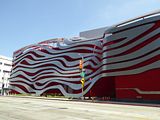
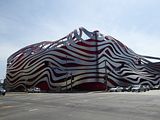
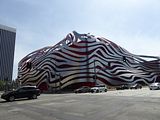
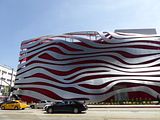
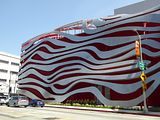
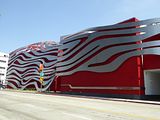
.jpg??width=180&height=120&fit=bounds)
.jpg??width=180&height=120&fit=bounds)
.jpg??width=180&height=120&fit=bounds)
.jpg??width=180&height=120&fit=bounds)
.jpg?width=180&height=120&fit=bounds)
.jpg?width=180&height=120&fit=bounds)
.jpg?width=180&height=120&fit=bounds)
.jpg?width=180&height=120&fit=bounds)
.jpg?width=180&height=120&fit=bounds)
.jpg??width=180&height=120&fit=bounds)
.jpg??width=180&height=120&fit=bounds)
.jpg??width=180&height=120&fit=bounds)
.jpg??width=180&height=120&fit=bounds)
.jpg??width=180&height=120&fit=bounds)
.jpg??width=180&height=120&fit=bounds)
.jpg??width=180&height=120&fit=bounds)
.jpg??width=180&height=120&fit=bounds)
.jpg??width=180&height=120&fit=bounds)
.jpg??width=180&height=120&fit=bounds)
.jpg??width=180&height=120&fit=bounds)
.jpg??width=180&height=120&fit=bounds)
.jpg??width=180&height=120&fit=bounds)
.jpg??width=180&height=120&fit=bounds)
.jpg??width=180&height=120&fit=bounds)
.jpg??width=180&height=120&fit=bounds)
.jpg??width=180&height=120&fit=bounds)
.jpg??width=180&height=120&fit=bounds)
.jpg??width=180&height=120&fit=bounds)
.jpg??width=180&height=120&fit=bounds)
.jpg??width=180&height=120&fit=bounds)
.jpg??width=180&height=120&fit=bounds)
.jpg??width=180&height=120&fit=bounds)
.jpg??width=180&height=120&fit=bounds)
.jpg??width=180&height=120&fit=bounds)
.jpg??width=180&height=120&fit=bounds)
.jpg??width=180&height=120&fit=bounds)
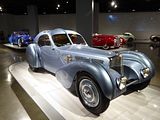
.jpg??width=180&height=120&fit=bounds)
.jpg??width=180&height=120&fit=bounds)
.jpg??width=180&height=120&fit=bounds)
.jpg??width=180&height=120&fit=bounds)
.jpg??width=180&height=120&fit=bounds)
.jpg??width=180&height=120&fit=bounds)
.jpg??width=180&height=120&fit=bounds)
.jpg??width=180&height=120&fit=bounds)
.jpg??width=180&height=120&fit=bounds)
.jpg??width=180&height=120&fit=bounds)
.jpg??width=180&height=120&fit=bounds)
.jpg??width=180&height=120&fit=bounds)
.jpg??width=180&height=120&fit=bounds)
.jpg??width=180&height=120&fit=bounds)
.jpg??width=180&height=120&fit=bounds)
.jpg??width=180&height=120&fit=bounds)
.jpg??width=180&height=120&fit=bounds)
.jpg??width=180&height=120&fit=bounds)
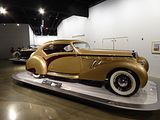
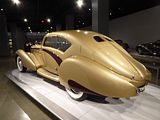
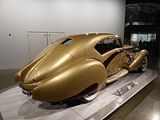
.jpg??width=180&height=120&fit=bounds)
.jpg??width=180&height=120&fit=bounds)
.jpg??width=180&height=120&fit=bounds)
.jpg??width=180&height=120&fit=bounds)
.jpg??width=180&height=120&fit=bounds)
.jpg??width=180&height=120&fit=bounds)
.jpg??width=180&height=120&fit=bounds)
.jpg??width=180&height=120&fit=bounds)
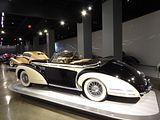
.jpg??width=180&height=120&fit=bounds)
.jpg??width=180&height=120&fit=bounds)
.jpg??width=180&height=120&fit=bounds)
.jpg??width=180&height=120&fit=bounds)
.jpg??width=180&height=120&fit=bounds)
.jpg??width=180&height=120&fit=bounds)
.jpg??width=180&height=120&fit=bounds)
.jpg??width=180&height=120&fit=bounds)
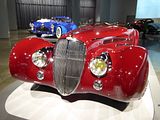
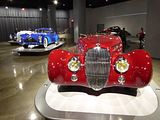
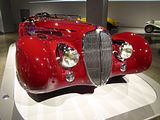
.jpg??width=180&height=120&fit=bounds)
.jpg??width=180&height=120&fit=bounds)
.jpg??width=180&height=120&fit=bounds)
.jpg??width=180&height=120&fit=bounds)
.jpg??width=180&height=120&fit=bounds)
.jpg??width=180&height=120&fit=bounds)
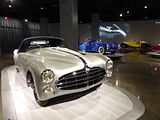
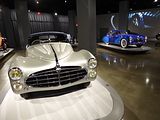
.jpg??width=180&height=120&fit=bounds)
.jpg??width=180&height=120&fit=bounds)
.jpg??width=180&height=120&fit=bounds)
.jpg??width=180&height=120&fit=bounds)
.jpg??width=180&height=120&fit=bounds)
.jpg??width=180&height=120&fit=bounds)
.jpg??width=180&height=120&fit=bounds)
.jpg??width=180&height=120&fit=bounds)
.jpg??width=180&height=120&fit=bounds)
.jpg??width=180&height=120&fit=bounds)
.jpg??width=180&height=120&fit=bounds)
.jpg??width=180&height=120&fit=bounds)
.jpg??width=180&height=120&fit=bounds)
.jpg??width=180&height=120&fit=bounds)
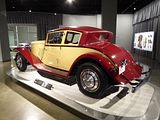
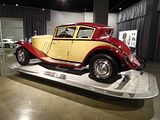
.jpg??width=180&height=120&fit=bounds)
.jpg??width=180&height=120&fit=bounds)
.jpg??width=180&height=120&fit=bounds)
.jpg??width=180&height=120&fit=bounds)
.jpg??width=180&height=120&fit=bounds)
.jpg??width=180&height=120&fit=bounds)
.jpg??width=180&height=120&fit=bounds)
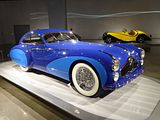
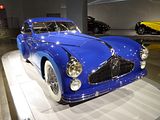
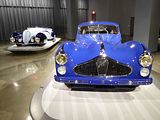
.jpg??width=180&height=120&fit=bounds)
.jpg??width=180&height=120&fit=bounds)
.jpg??width=180&height=120&fit=bounds)
.jpg??width=180&height=120&fit=bounds)
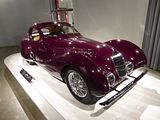

.jpg??width=180&height=120&fit=bounds)
.jpg??width=180&height=120&fit=bounds)
.jpg??width=180&height=120&fit=bounds)
.jpg??width=180&height=120&fit=bounds)
.jpg??width=180&height=120&fit=bounds)

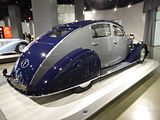
.jpg??width=180&height=120&fit=bounds)
.jpg??width=180&height=120&fit=bounds)
.jpg??width=180&height=120&fit=bounds)
.jpg??width=180&height=120&fit=bounds)
.jpg??width=180&height=120&fit=bounds)
.jpg??width=180&height=120&fit=bounds)
.jpg??width=180&height=120&fit=bounds)
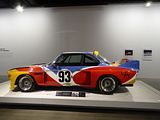
.jpg??width=180&height=120&fit=bounds)
.jpg??width=180&height=120&fit=bounds)
.jpg??width=180&height=120&fit=bounds)
.jpg??width=180&height=120&fit=bounds)
.jpg??width=180&height=120&fit=bounds)
.jpg??width=180&height=120&fit=bounds)
.jpg??width=180&height=120&fit=bounds)
.jpg??width=180&height=120&fit=bounds)
.jpg??width=180&height=120&fit=bounds)
.jpg??width=180&height=120&fit=bounds)
.jpg??width=180&height=120&fit=bounds)
.jpg??width=180&height=120&fit=bounds)
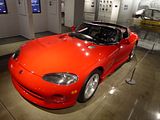
.jpg??width=180&height=120&fit=bounds)
.jpg??width=180&height=120&fit=bounds)
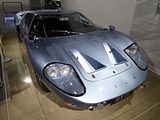
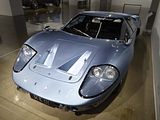
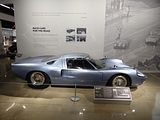
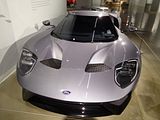
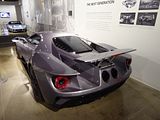
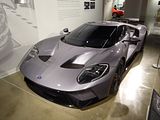
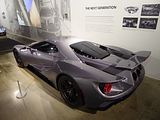
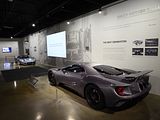
.jpg??width=180&height=120&fit=bounds)
